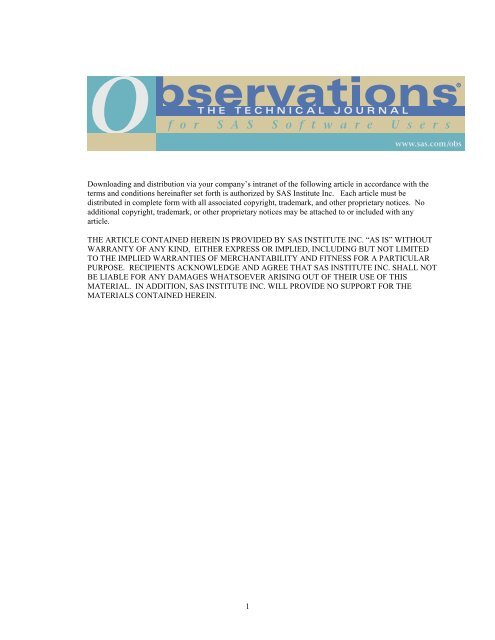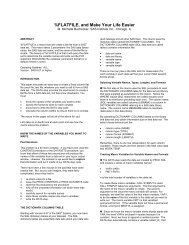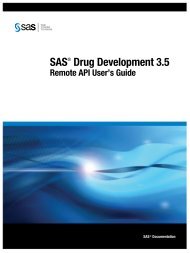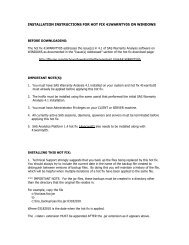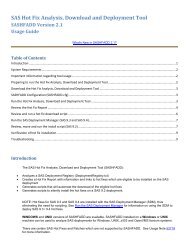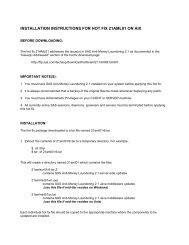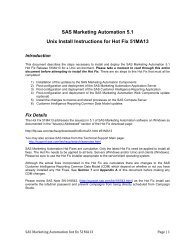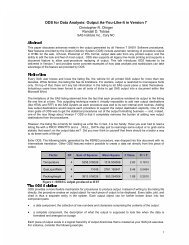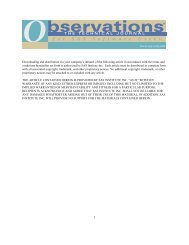Using the TABULATE Procedure for Computing Event Rates - Ftp Sas
Using the TABULATE Procedure for Computing Event Rates - Ftp Sas
Using the TABULATE Procedure for Computing Event Rates - Ftp Sas
Create successful ePaper yourself
Turn your PDF publications into a flip-book with our unique Google optimized e-Paper software.
Downloading and distribution via your company’s intranet of <strong>the</strong> following article in accordance with <strong>the</strong>terms and conditions hereinafter set <strong>for</strong>th is authorized by SAS Institute Inc. Each article must bedistributed in complete <strong>for</strong>m with all associated copyright, trademark, and o<strong>the</strong>r proprietary notices. Noadditional copyright, trademark, or o<strong>the</strong>r proprietary notices may be attached to or included with anyarticle.THE ARTICLE CONTAINED HEREIN IS PROVIDED BY SAS INSTITUTE INC. “AS IS” WITHOUTWARRANTY OF ANY KIND, EITHER EXPRESS OR IMPLIED, INCLUDING BUT NOT LIMITEDTO THE IMPLIED WARRANTIES OF MERCHANTABILITY AND FITNESS FOR A PARTICULARPURPOSE. RECIPIENTS ACKNOWLEDGE AND AGREE THAT SAS INSTITUTE INC. SHALL NOTBE LIABLE FOR ANY DAMAGES WHATSOEVER ARISING OUT OF THEIR USE OF THISMATERIAL. IN ADDITION, SAS INSTITUTE INC. WILL PROVIDE NO SUPPORT FOR THEMATERIALS CONTAINED HEREIN.1
<strong>Using</strong> <strong>the</strong> <strong>TABULATE</strong> <strong>Procedure</strong> <strong>for</strong> <strong>Computing</strong> <strong>Event</strong><strong>Rates</strong> and Describing Variability in Safety and EfficacyAssessmentsDavid Olaleye and Jim GoinDavid Olaleye is a Pharmaceutical Industry Technologist at SAS Institute. Prior to joining <strong>the</strong> Institute, Davidworked as a Senior Statistician/Statistical Programming Manager with DataMedix Corporation located in Wayne,Pennsylvania. He has been a SAS user <strong>for</strong> <strong>the</strong> past 9 years, spending <strong>the</strong> last 4 years in consulting <strong>for</strong>pharmaceutical industries and academia. His areas of SAS expertise include base SAS software, <strong>the</strong> SAS MacroLanguage, SAS/STAT software and application development using SAS/FSP and SAS/AF software with FRAMEentries. He also uses SAS to generate statistical analysis plans <strong>for</strong> clinical trials protocols, efficacy and safetytables/listings <strong>for</strong> New Drug Application submission. He has a Ph.D. in Demography (with concentration inStatistics) from <strong>the</strong> University of Pennsylvania, Philadelphia. David is a member of North-East SAS User Group.James E. Goin is President and Founder of DataMedix Corporation, which is a contract research organization andbiomedical consulting firm. He is a statistical and regulatory consultant to numerous pharmaceutical, biotechnology,device, and imaging companies, and has been a SAS user <strong>for</strong> many years. He currently uses SAS in <strong>the</strong> design andanalysis of phase I through phase IV clinical research studies <strong>for</strong> evaluating <strong>the</strong> efficacy and safety of new drugs,biologicals, devices and <strong>the</strong>rapeutic interventions. He received his Ph.D. in biostatistics from <strong>the</strong> University ofOklahoma in 1975.AbstractThe objective of this article is two-fold: (1) to illustrate <strong>the</strong> use of PROC <strong>TABULATE</strong> <strong>for</strong> computing event ratesusing <strong>the</strong> life table method and (2) to show how <strong>the</strong> <strong>TABULATE</strong> procedure can be used to describe variability infailure times (or any o<strong>the</strong>r efficacy measure) <strong>for</strong> patients exposed to different treatment doses. The latter objectivedisplays summary statistics along with percentages that describe <strong>the</strong> failure times distribution in terms of quartiles.Equivalent DATA steps <strong>for</strong> computing event rates as demonstrated <strong>for</strong> <strong>the</strong> first objective are also shown.Contents• Introduction• Part I: <strong>Using</strong> PROC <strong>TABULATE</strong> to Compute <strong>Event</strong> <strong>Rates</strong>• Part II: <strong>Using</strong> PROC <strong>TABULATE</strong> to Present Percentile In<strong>for</strong>mation• Summary• ReferencesIntroductionThe <strong>TABULATE</strong> procedure is a powerful tool <strong>for</strong> creating tabular reports and displaying hierarchical relationshipamong two or more variables in a single table. In most instances, <strong>the</strong> <strong>TABULATE</strong> procedure meets <strong>the</strong> needs of aclinical data analyst or statistical programmer when data summaries need only be presented as proportions andpercentages, or as simple descriptive statistics such as <strong>the</strong> mean and standard deviation.This article describes how PROC <strong>TABULATE</strong> can be extended to compute event rates such as failure, mortality,and adverse event rates using <strong>the</strong> life table method (Elandt-Johnson and Johnson, 1980). Tabulation of event ratescan be helpful in complying with U.S. Food and Drug Administration (FDA) and o<strong>the</strong>r regulatory agencies’requirements <strong>for</strong> an application to market a new drug. <strong>Event</strong> rates can be used to summarize safety data, <strong>for</strong>example, by describing <strong>the</strong> overall event profile of <strong>the</strong> drug. <strong>Event</strong> rates can also be employed to compare efficacyassessments across treatment groups, (<strong>for</strong> example, <strong>for</strong> comparison of failure time or time to virus positivity betweentreatments).2
This article also describes how to use a combination of DATA steps with PROC <strong>TABULATE</strong> to generate anddisplay summary statistics <strong>for</strong> failure times by treatment and study period. The summary statistics include means,standard deviations, and in<strong>for</strong>mation derived from <strong>the</strong> ranked distribution of patients’ failure times. Reportsgenerated in this manner may facilitate interpretation of <strong>the</strong> results of a clinical trial, and may be included in aclinical study report or in an integrated summary of safety or efficacy data.Part I: <strong>Using</strong> PROC <strong>TABULATE</strong> to Compute <strong>Event</strong> <strong>Rates</strong>This article utilizes two sample data sets to show how PROC <strong>TABULATE</strong> can be used to compute different types ofevent rates.First Example Data SetThe first sample data came from a randomized clinical trial comparing <strong>the</strong> Halstead mastectomy with <strong>the</strong>quadrantectomy plus axillary dissection and radio<strong>the</strong>rapy in early breast cancer patients (Veronesi et al. 1981). Asample of 701 patients diagnosed as having a breast cancer less than 2cm in diameter without palpable nodes wereenrolled in <strong>the</strong> trial. The researcher was interested in studying time free from different types of competing eventssuch as distant disease (metastates), ipsilateral breast tumor, controlateral tumor, and death. For illustrationpurposes, 10 individual records randomly selected from <strong>the</strong> entire data set are used. The date of surgery(SURG_DT) represents <strong>the</strong> individual patient’s entry into <strong>the</strong> study, while <strong>the</strong> date of death (DEATH_DT) or date oflast contact (CONT_DT) represents <strong>the</strong> day that <strong>the</strong> patient died or was last observed. The observation time(YEARS), measured in years, is <strong>the</strong> difference between SURG_DT and CONT_DT or DEATH_DT. The raw dataand <strong>the</strong> SAS DATA step that generated <strong>the</strong> SAS data set are given below:data breast (keep=id years positive);input @1 id @4 surg_dt ddmmyy8. @14 cont_dt ddmmyy8. @24 death_dt ddmmyy8.@34 years @40 positive;<strong>for</strong>mat surg_dt cont_dt death_dt ddmmyy8.;label id=’Observation ID’surg_dt=’Surgery Date’cont_dt=’Date of Last Contact’death_dt=’Date of Death’years=’Observation time (years)’positive=’Indicator of failure: 1=event 0=censored’;cards;1 27/06/73 . 14/04/84 10.81 12 17/07/73 27/01/92 . 18.49 03 28/01/74 18/11/91 . 17.82 04 29/04/76 08/01/91 . 14.70 05 17/01/77 . 28/09/85 8.70 16 19/04/78 . 15/12/88 10.67 17 24/07/78 12/05/92 . 13.45 08 26/07/78 08/06/92 . 13.43 09 23/04/80 . 08/03/85 4.88 110 30/04/80 11/03/92 . 11.68 0;run;Second Example Data SetThe second sample data set comes from <strong>the</strong> AIDS virus data reported in Wei et al. (1989). The data were collectedin a randomized clinical trial that sought to evaluate <strong>the</strong> effectiveness of <strong>the</strong> drug ribavirin among patients withacquired immune deficiency syndrome (AIDS) who were assigned to one of three treatment groups: placebo, lowdose, and high dose of ribavirin. Blood samples were collected at weeks 4, 8, and 12, and each sample was observedeach day to evaluate HIV viral load until virus positivity was detected via a surrogate marker. The day that viruspositivity was detected is <strong>the</strong> failure time. As an example, if a sample was negative on days 1, 2, and 3, and on day 4became positive, <strong>the</strong>n <strong>the</strong> number of days to virus positivity is 4 and <strong>the</strong> failure time is 4 days. Since only AIDS3
patients were enrolled in <strong>the</strong> trial, potentially each patient in <strong>the</strong> study should have three such failure times.Censored observations occurred when <strong>the</strong> culture required more days to register as positive than were achievable in<strong>the</strong> laboratory, or when <strong>the</strong> sample was contaminated be<strong>for</strong>e positivity was detected. The raw data and <strong>the</strong> DATAstep that generated <strong>the</strong> SAS data set are given below:data virus (keep=id sample treat days positive);array mth month1-month3;retain id sample 0;input treat month1-month3;id + 1;do over mth;if mth ^= . <strong>the</strong>ndo;if mth < 0 <strong>the</strong>n do; days= -mth; positive= 0; end;elsesample= _i_;output;end;end;cards;1 9 6 71 4 5 101 6 7 61 10 . -211 15 8 .1 3 . 61 4 7 31 9 12 121 9 19 -191 6 5 61 9 . 181 9 -20 -172 6 4 52 16 17 -212 31 -19 -212 -27 -19 .2 7 16 -232 -28 7 -192 -28 3 162 15 12 162 18 -21 222 8 4 72 4 -21 73 21 9 -83 13 7 -213 16 6 203 3 8 63 21 . -253 7 19 33 11 13 -213 -27 -18 93 14 14 63 8 11 153 8 4 73 8 3 93 -19 10 -17;run;do; days= mth; positive= 1; end;4
CautionThe analysis of mortality and failure times demonstrated with PROC <strong>TABULATE</strong> in this article does not attempt toestablish or evaluate <strong>the</strong> effectiveness of ei<strong>the</strong>r <strong>the</strong> breast cancer treatment <strong>the</strong>rapy or ribavirin. There<strong>for</strong>e, noconclusion should be drawn from <strong>the</strong> results presented. The demonstration is simply <strong>for</strong> illustration purposes and toshow that <strong>the</strong> function of PROC <strong>TABULATE</strong> can be extended to compute event rates.Deriving Variables <strong>for</strong> Calculation of <strong>Event</strong> <strong>Rates</strong>Computation of event rates such as mortality and virus positivity rates involves two factors: (1) identifying <strong>the</strong>number of observed events, ei<strong>the</strong>r deaths or failures (numerator), and (2) <strong>the</strong> total observation time <strong>for</strong> all subjects inperson-time units (denominator). Counting <strong>the</strong> number of events in <strong>the</strong> numerator term is straight<strong>for</strong>ward.Computation of <strong>the</strong> denominator term requires <strong>the</strong> following: (1) <strong>the</strong> total duration time <strong>for</strong> subjects whoexperienced <strong>the</strong> events; (2) <strong>the</strong> total duration period up to <strong>the</strong> last day of interval <strong>for</strong> o<strong>the</strong>r subjects who did notexperience <strong>the</strong> event; and (3) <strong>the</strong> duration period up to <strong>the</strong> last evaluated day <strong>for</strong> subjects who are lost to follow-upor who discontinued <strong>the</strong> study.Reasons <strong>for</strong> this include <strong>the</strong> fact that <strong>the</strong> longer a subject is observed, <strong>the</strong> greater likelihood <strong>the</strong>re is <strong>for</strong> failure, and<strong>the</strong> greater <strong>the</strong> ”weight” to be assigned to a subject in <strong>the</strong> evaluation (Marubini and Valsecchi, 1995).<strong>Using</strong> <strong>the</strong> first sample data set, <strong>the</strong> SAS code below shows how to process <strong>the</strong> data and derive <strong>the</strong> variables neededto calculate event rates:proc <strong>for</strong>mat;value positive 1=’<strong>Event</strong>’ 0=’Censored’;value yearfmt 1=’[0,5)’ 2=’[5,10)’ 3=’[10,15)’ 4=’15+’;run;data _temp2_;set breast;if 0
observation is censored or is an event. As demonstrated in <strong>the</strong> following PROC <strong>TABULATE</strong> statements, <strong>the</strong> FAILvariable is used in creating <strong>the</strong> numerator term, and N_YEARS is used in creating <strong>the</strong> denominator term.Case 1: Calculating Mortality <strong>Rates</strong>Figure 1 presents output from our extension of PROC <strong>TABULATE</strong> that computes mortality rates. The followingPROC <strong>TABULATE</strong> statements show how to request and obtain <strong>the</strong> numerator and denominator terms needed tocompute <strong>the</strong> breast cancer mortality rate. The CLASS statement identifies <strong>the</strong> INTERVAL variable as <strong>the</strong>classification variable. The VAR statement lists <strong>the</strong> analysis variables that PROC <strong>TABULATE</strong> uses to compute <strong>the</strong>following totals: number of subjects at risk within a given interval (N_INTV, column 2 in <strong>TABULATE</strong> procedureoutput), number of subjects censored due no follow-up or end of observation period (CENSOR, column 3), numberexperiencing <strong>the</strong> event (FAIL, column 4), and <strong>the</strong> total person-years attributable to subjects in <strong>the</strong> at-risk set(N_YEARS, column 5).The event (mortality) rate shown in column 6 in <strong>the</strong> <strong>TABULATE</strong> procedure output is calculated as <strong>the</strong> ratio of <strong>the</strong>total number of observed deaths to <strong>the</strong> total time all subjects in a given interval have been observed (that is, column4/column 5). The term fail=’ ’ *pctsum=’Mortality Rate (%)’ contained in <strong>the</strong> TABLE statement tells<strong>TABULATE</strong> to summarize <strong>the</strong> values of <strong>the</strong> FAIL variable within each given interval and to divide it by <strong>the</strong> sum of<strong>the</strong> values of <strong>the</strong> N_YEARS variable in that same interval multiplied by 100 to obtain <strong>the</strong> mortality rate <strong>for</strong> <strong>the</strong>interval. For example, during <strong>the</strong> first five years of follow-up, <strong>the</strong>re was one death (which occurred at 4.88 years)and <strong>the</strong> remaining 9 subjects survived through <strong>the</strong> entire interval. Thus, <strong>the</strong> rate in this first interval is calculated as0.02 or [1/(4.88+9*5) * 100 =2%]. Similarly, <strong>for</strong> <strong>the</strong> next interval, <strong>the</strong> estimate of mortality rate <strong>for</strong> <strong>the</strong> 9 subjects atrisk is 0.023 or [1/(3.70+8*5) * 100 =2.3%]. For <strong>the</strong> entire sample, <strong>the</strong> estimated mortality rate is given in column 6of <strong>the</strong> last row [4/(50+44+25+6)*100=3.21]. The term misstext=’0’ is used to replace all cells having missingvalues with 0.proc sort data=_temp2_; by interval; run;options center nonumber nodate ps=54 ls=80;proc tabulate data=_temp2_ order=data <strong>for</strong>mat=10. missing;class interval;var n_years censor fail n_intv;table (interval=’Time Interval’ all=’Overall’),(n_intv=’Number Interval’*N=’ ’*f=8.) (censor=’Number Censored’*sum=’ ’*f=8.)(fail=’Number Failed’*sum=’ ’*f=7.) (n_years=’Person-Years’*sum=’ ’*f=8.)(fail=’ ’ * pctsum=’Mortality Rate (%)’* F=9.2)/ misstext=’0’ rts=22 condense box=’Breast Cancer Sample’;<strong>for</strong>mat interval yearfmt. ;title1 "Figure 1. Calculate <strong>Event</strong> <strong>Rates</strong> <strong>for</strong> Early Breast Cancer Patients in";title2 "Veronesi et al.’s (1981) study";run;Deriving Variables <strong>for</strong> Calculation of Virus Positivity <strong>Rates</strong>The second sample data is used to demonstrate calculation of virus positivity rates <strong>for</strong> blood samples collected atdifferent time points in an AIDS clinical trial study. The SAS code below shows how to process <strong>the</strong> data and derive<strong>the</strong> variables needed to calculate <strong>the</strong> event rates. Explanation of <strong>the</strong> code follows <strong>the</strong> same manner that was used <strong>for</strong>processing <strong>the</strong> data set <strong>for</strong> breast cancer mortality rate. Here, <strong>the</strong> unit measurement <strong>for</strong> observation period is days. AGROUP variable is created to classify <strong>the</strong> time to virus positivity or end of observation period (DAYS) into 5-dayintervals. Ano<strong>the</strong>r variable, SAMPLE, is used to stratify <strong>the</strong> blood samples by week of collection (stratum variable).For efficacy assessment of ribavirin, <strong>the</strong> purpose in this case is to facilitate comparison of <strong>the</strong> estimated positivityrates <strong>for</strong> <strong>the</strong> different dose groups of ribavirin across blood sample collection weeks.6
proc <strong>for</strong>mat;value sample 1='Week 4' 2='Week 8' 3='Week 12' 9=’All Blood Samples’;value treat 1='Placebo' 2='Low Dose' 3='High Dose' 9='Overall';value positive 1='<strong>Event</strong>' 0='Censored';value interval 1='[0,5)' 2='[5,10)' 3='[10,15)' 4='[15,20)'5='[20,25)' 6='[25,30)' 7='30+';run;data _temp2b_;set virus;if 1
collection and <strong>the</strong> combined blood samples. The term misstext=’0’ is used to replace all cells having missing valueswith 0.proc sort data=_temp2b_; by sample treat interval; run;options center nonumber nodate ps=54 ls=80;proc tabulate data=_temp2b_ order=data <strong>for</strong>mat=10. missing ;class sample treat interval;var n_days censor fail n_intv;table (sample=’ ’ ALL=’All Blood Samples’),(treat=’Treatment Group’) * (interval=’Time Interval’),(n_intv=’Number Interval’*N=’ ’*f=8.) (censor=’Number Censored’*sum=’’*f=8.)(fail=’Number Failed’ * sum=’ ’*f=8.) (n_days=’Culture-Days’*sum=’ ’*f=8.)(fail=’ ’ * pctsum=’<strong>Event</strong> Rate (%)’* F=14.2)/ misstext=’0’ rts=22 condense box=_page_;<strong>for</strong>mat sample sample. interval interval. treat treat.;title1 "Figure 2: Calculate Virus Positivity <strong>Rates</strong> <strong>for</strong> Each Treatment Group<strong>for</strong>";title2 "Blood Samples at Weeks 4, 8, 12 and All Combined Blood Samples";run;Validation of <strong>Event</strong> Rate ComputationsSAS DATA step solution that computes virus positivity rates similar to those obtained from <strong>the</strong> code in <strong>the</strong>preceding section is given below. The output of this validation code is <strong>the</strong> same as that presented in Figure 2 and hasbeen omitted in this article <strong>for</strong> reasons of brevity.data _temp2b_;set virus;if 1
n_intv+1;p_days+n_days;if censor=1 <strong>the</strong>n n_cens+censor;if fail=1 <strong>the</strong>n n_fail+fail;rate=n_fail/p_days*100;if last.interval <strong>the</strong>n output;drop id positive censor fail days n_days;run;proc sort data=_temp2b_; by treat interval id; run;data _temp4_;set _temp2_(drop=n_intv) end=last;by treat interval id;sample=9;/*Category <strong>for</strong> Total of all blood samples combined*/if first.interval <strong>the</strong>n do; n_intv=0; p_days=0; n_cens=0; n_fail=0; end;n_intv+1;p_days+n_days;if censor=1 <strong>the</strong>n n_cens+censor;if fail=1 <strong>the</strong>n n_fail+fail;rate=n_fail/p_days*100;if last.interval <strong>the</strong>n output;drop id positive censor fail days n_days;run;data _temp34_;set _temp3_ _temp4_;proc fsview data=_temp34_;run;options center nonumber nodate ps=54 ls=80;proc tabulate data=_temp34_ order=data <strong>for</strong>mat=10. missing ;class sample treat interval;var n_intv p_days n_cens n_fail rate;table sample=’ ’,(treat=’Treatment Group’) * (interval=’Time Interval’),(n_intv=’Number Interval’*sum=’ ’*f=8.) (n_cens=’Number Censored’*sum=’’*f=8.)(n_fail=’Number Failed’*sum=’ ’*f=8.) (p_days='Culture-Days’*sum=' '*f=8.)(rate='<strong>Event</strong> Rate(%)' * sum=' '*f=14.2)/ misstext='0' rts=22 condense box=_page_;<strong>for</strong>mat sample sample. interval interval. treat treat.;title1 "<strong>Using</strong> DATA Step and By-Group Statements to Validate and Reproduce";title2 "Life Table Estimates Obtained with Proc Tabulate in Figure 2";title3 "Compute <strong>Event</strong> <strong>Rates</strong> <strong>for</strong> Each Treatment Group by Blood Sample andCombined Blood Sample";run;The SAS DATA step solution yields <strong>the</strong> same results obtained with <strong>the</strong> previous SAS code. Although both SASprograms employ <strong>the</strong> <strong>TABULATE</strong> procedure to report <strong>the</strong> results, this particular program uses more lines of SAScode, computes <strong>the</strong> event rates within <strong>the</strong> SAS DATA step, and computes <strong>the</strong> values <strong>for</strong> <strong>the</strong> combined totals (that is,all blood samples) in a different DATA step. On <strong>the</strong> o<strong>the</strong>r hand, <strong>the</strong> previous SAS program makes maximum use of<strong>the</strong> functions and computing power of <strong>the</strong> <strong>TABULATE</strong> procedure.9
Part II: <strong>Using</strong> PROC <strong>TABULATE</strong> to Present Percentile In<strong>for</strong>mationThe second part of this article describes <strong>the</strong> use of PROC <strong>TABULATE</strong> <strong>for</strong> generating percentile in<strong>for</strong>mation thatcan be used to describe <strong>the</strong> distribution of an efficacy variable of interest or make comparisons across different setsof data or samples. This example is illustrated by comparing <strong>the</strong> failure times (time to detection of virus positivity)of blood samples obtained from patients exposed to different doses of ribavirin or placebo at different times.Presently, PROC <strong>TABULATE</strong> computes different <strong>for</strong>ms of summary statistics which include <strong>the</strong> mean, range, andstandard deviation <strong>for</strong> any given data set. Details on how to obtain such statistics can be found in <strong>the</strong> SAS Guide to<strong>TABULATE</strong> Processing, Second Edition. However, <strong>the</strong>re are instances when one may want to show additionalin<strong>for</strong>mation about <strong>the</strong> behavior of an efficacy variable of interest to complement <strong>the</strong> statistics provided by PROC<strong>TABULATE</strong>. For example, one may wish to show how <strong>the</strong> values of <strong>the</strong> variable are distributed across differenttreatment groups or strata. Descriptive statistics to adopt in this circumstance might include quartiles, deciles andpercentiles. These statistics are referred to as measures of location and <strong>the</strong>y are useful <strong>for</strong> comparing values ordescribing <strong>the</strong> distribution of values of a given variable. Quartiles divide <strong>the</strong> ranked scores into four equal parts.(Q 1 , Q 2 , and Q 3 are <strong>the</strong> values that divide <strong>the</strong> parts.) Q 1 separates <strong>the</strong> bottom 25% of <strong>the</strong> ranked scores from <strong>the</strong> top75%; Q 2 (known as <strong>the</strong> median) separates <strong>the</strong> ranked scores into two equal parts; and Q 3 separates <strong>the</strong> top 25% of<strong>the</strong> ranked scores from <strong>the</strong> bottom 75%. In <strong>the</strong> same way, deciles partition <strong>the</strong> data into 10 groups with about 10% of<strong>the</strong> data in each group, while percentiles partition <strong>the</strong> data into 100 groups with about 1% of <strong>the</strong> scores in eachgroup. In SAS, <strong>the</strong>se measures are produced by PROC UNIVARIATE.Deriving Variables <strong>for</strong> Calculating Percentages of Failure TimesThe following SAS code was used to process <strong>the</strong> data set needed <strong>for</strong> deriving variables to calculate percentages offailure times. The code is summarized in <strong>the</strong> following steps. First, using <strong>the</strong> second example SAS data set(VIRUS), a new data set (STATS) was created using <strong>the</strong> OUT= option in PROC UNIVARIATE. The data setcontained <strong>the</strong> quartiles (or if desired, deciles or percentiles) and <strong>the</strong> minimum and maximum values of <strong>the</strong> efficacyvariable. In this example, <strong>the</strong> efficacy variable is time to virus positivity detection (DAYS).Second, in <strong>the</strong> next DATA step <strong>the</strong> values of <strong>the</strong> quartiles and o<strong>the</strong>r statistics are passed to macro variables using <strong>the</strong>CALL SYMPUT statement. Also in this DATA step, ano<strong>the</strong>r macro variable (TOTCAT) was created to hold <strong>the</strong>value that will be used to represent <strong>the</strong> ‘Total’ category in <strong>the</strong> PROC FORMAT definition <strong>for</strong> <strong>the</strong> QUARTILEvariable. Third, PROC FORMAT was used to create <strong>for</strong>matted labels <strong>for</strong> categories of QUARTILE. [Caution: Theplacement of PROC FORMAT statements used <strong>for</strong> creating <strong>for</strong>matted labels of QUARTILE is very important. The<strong>for</strong>mat definition must come after <strong>the</strong> DATA step used to create <strong>the</strong> macro variables. O<strong>the</strong>rwise, SAS will reporterror messages to <strong>the</strong> LOG window <strong>for</strong> not being able to resolve <strong>the</strong> macro variables used in <strong>the</strong> PROC FORMATstatements.] The last DATA step creates a SAS data set (_TEMP3_) that will be used in PROC <strong>TABULATE</strong>. Inaddition, <strong>the</strong> values of <strong>the</strong> macro variables are used to create categories <strong>for</strong> <strong>the</strong> QUARTILE variable.In this example, summarization of data using in<strong>for</strong>mation on quartiles computed from <strong>the</strong> patients’ failure timesserves two purposes: (1) to compare percentages of failure times both across treatment groups and blood samplecollection weeks and (2) to facilitate detection of whe<strong>the</strong>r <strong>the</strong> variable of interest has <strong>the</strong> same or skeweddistribution across <strong>the</strong> treatment groups.proc univariate data=virus noprint;var days;output out=stats min=min max=max median=med q1=q1 q3=q3;run;data stats;set stats;call symput(’min’,left(min));call symput(’max’,left(max));call symput(’med’,left(med));call symput(’med_’,left(med+1));call symput(’q1’,left(q1));10
call symput(’q3’,left(q3));call symput(’q1_’,left(q1+1));call symput(’q3_’,left(q3+1));call symput(’totcat’,left(max+10)); /*Macro variable to represent <strong>the</strong>*//*value <strong>for</strong> <strong>the</strong> Total Category*/run;proc <strong>for</strong>mat;value quartile 1="%left(&min) to &q1" 2="%left(&q1_) to &med"3="%left(&med_) to &q3" 4="%left(&q3_) to &max"&totcat=’Total’;value sample 1=’Week 4’ 2=’Week 8’ 3=’Week 12’ 9=’Total’;value treat 1=’Placebo’ 2=’Low Dose’ 3=’High Dose’ 9=’Overall’;run;data _temp5_;set virus;if &min
<strong>for</strong>mat treat treat. sample sample. quartile quartile. positive positive.;title1 "Figure 3: Descriptive Summary Statistics of Time to VirusPositivity";title2 "Detection by Treatment, <strong>Event</strong> Status and Blood Sample CollectionWeek";run;Output from ano<strong>the</strong>r example of PROC <strong>TABULATE</strong> is presented in Figure 4. The output gives <strong>the</strong> descriptivesummary statistics of time to virus positivity by treatment group and blood sample collection week. Here, <strong>the</strong> rowsof <strong>the</strong> table show a hierarchical relationship, with respect to time to virus positivity, by <strong>the</strong> patient’s treatment groupassignment and week of blood sample collection. The columns display <strong>the</strong> descriptive aggregate in<strong>for</strong>mation on apatient’s blood sample time to virus positivity.options center nonumber nodate ps=43 ls=126;proc tabulate data=_temp_ order=data <strong>for</strong>mat=6.1 missing;class sample treat quartile;var days;table (treat=’Treatment’ ALL=’All Group’)* (sample=’Sample’ ALL=’Total’),(quartile=’Failure Times (Quartiles)’ * (N*f=4. pctn)all=’Total’*(N*f=6. pctn))days=’Failure Times (Days)’ * (N*f=4. Mean std Min Max)/ misstext=’0’ rts=22 condense box=_page_;<strong>for</strong>mat treat treat. sample sample. quartile quartile. positive positive.;title1 "Figure 4: Descriptive Summary Statistics of Time to Detection ofVirus";title2 "Positivity by Treatment and Blood Sample Collection Week";run;SummaryThis article describes two different applications of PROC <strong>TABULATE</strong> <strong>for</strong> summarizing and reporting data. Thearticle also shows that <strong>the</strong> functions of <strong>the</strong> <strong>TABULATE</strong> procedure can be extended to compute event rates such asmortality rate or virus positivity rates. The beauty of using PROC <strong>TABULATE</strong> as a reporting tool lies in itssimplicity and parsimony. A reporting task that requires many lines of code with SAS DATA steps and PUTstatements can be easily accomplished with one or two PROC <strong>TABULATE</strong> statements. The SAS macro programspresented in this article can be generalized to compute o<strong>the</strong>r similar event rates.This paper also highlights <strong>the</strong> use of PROC <strong>TABULATE</strong> <strong>for</strong> producing customized tables and descriptive summaryin<strong>for</strong>mation on an efficacy variable of interest. Two examples show a concatenated output of summary statistics andpercentages derived from quartiles of <strong>the</strong> ranked distribution of time to virus positivity.ReferencesBernholc, Alissa (1997), “A Tip <strong>for</strong> <strong>Using</strong> <strong>the</strong> <strong>TABULATE</strong> <strong>Procedure</strong>: Generating Tables with Percentages in OnlyOne Category,” Observations, The Technical Journal <strong>for</strong> SAS Software Users, Cary, NC: SAS Institute Inc.Elandt-Johnson, R.C. and Johnson, N.L. (1980), “Survival Models and Data Analysis,” New York: John Wiley &Sons, Inc.Kent, Paul (1995), "SQL Joins - The Long and The Short of It." Proceedings of <strong>the</strong> Twentieth Annual SAS UsersGroup International Conference, Cary, NC: SAS Institute Inc., 206-215.L.J. Wei, D.Y. Lin, and L. Weissfeld (1989), "Regression Analysis of Multivariate Incomplete Failure Time Data byModeling Marginal Distribution," Journal of <strong>the</strong> American Statistical Association, 84, 1065-1071.12
SAS Institute Inc. (1990), SAS Guide to <strong>TABULATE</strong> Processing, Second Edition, Cary, NC: SAS Institute Inc., 208.SAS Institute Inc. (1997), SAS Macro Language: Reference, Cary, NC: SAS Institute Inc., 96-99, 175-176.Veronesi U. et al. (1981), "Comparing radical mastectomy with quadrantectomy, axillary dissection andradio<strong>the</strong>rapy in patients with small cancers of <strong>the</strong> breast,” New England Journal of Medicine, 305, 6-11.Modified code is not supported by <strong>the</strong> authors or SAS Institute.13
Figure 1. Calculate <strong>Event</strong> <strong>Rates</strong> <strong>for</strong> Early Breast Cancer Patients inVeronesi et al.’s (1981) study_%UHDVW&DQFHU6DPSOH_1XPEHU_1XPEHU_1XPEHU_3HUVRQ_0RUWDOLW\___,QWHUYDO_&HQVRUHG_)DLOHG__________>_________>__________________2YHUDOO______14
Figure 2: Calculate Virus Positivity <strong>Rates</strong> <strong>for</strong> Each Treatment Group <strong>for</strong> Blood Samples at Weeks 4, 8, 12and All Combined Blood Samples_:HHN_1XPEHU_1XPEHU_1XPEHU_&XOWXUH____,QWHUYDO_&HQVRUHG_)DLOHG_'D\V_(YHQW5DWH____7UHDWPHQW_7LPH_______*URXS_,QWHUYDO______________3ODFHER_>___________>___________>_________/RZ'RVH_>___________>___________>___________>___________>___________>____________________+LJK'RVH_>___________>___________>___________>___________>___________>______15
Figure 2 (continued): Calculate Virus Positivity <strong>Rates</strong> <strong>for</strong> Each Treatment Group <strong>for</strong> Blood Samples atWeeks 4, 8, 12 and All Combined Blood Samples_:HHN_1XPEHU_1XPEHU_1XPEHU_&XOWXUH____,QWHUYDO_&HQVRUHG_)DLOHG_'D\V_(YHQW5DWH____7UHDWPHQW_7LPH_______*URXS_,QWHUYDO______________3ODFHER_>___________>___________>___________>_________/RZ'RVH_>___________>___________>___________>___________>_________+LJK'RVH_>___________>___________>___________>______16
Figure 2 (continued): Calculate Virus Positivity <strong>Rates</strong> <strong>for</strong> Each Treatment Group <strong>for</strong> Blood Samples atWeeks 4, 8, 12 and All Combined Blood Samples_:HHN_1XPEHU_1XPEHU_1XPEHU_&XOWXUH____,QWHUYDO_&HQVRUHG_)DLOHG_'D\V_(YHQW5DWH____7UHDWPHQW_7LPH_______*URXS_,QWHUYDO______________3ODFHER_>___________>___________>___________>___________>_________/RZ'RVH_>___________>___________>___________>___________>_________+LJK'RVH_>___________>___________>___________>___________>______17
Figure 2 (continued): Calculate Virus Positivity <strong>Rates</strong> <strong>for</strong> Each Treatment Group <strong>for</strong>Blood Samples at Weeks 4, 8, 12 and All Combined Blood Samples_$OO%ORRG6DPSOHV_1XPEHU_1XPEHU_1XPEHU_&XOWXUH____,QWHUYDO_&HQVRUHG_)DLOHG_'D\V_(YHQW5DWH____7UHDWPHQW_7LPH_______*URXS_,QWHUYDO______________3ODFHER_>___________>___________>___________>___________>_________/RZ'RVH_>___________>___________>___________>___________>___________>____________________+LJK'RVH_>___________>___________>___________>___________>___________>______18
Figure 3: Descriptive Summary Statistics of Time to Virus Positivity Detection by Treatment, <strong>Event</strong> Status and Blood SampleCollection WeekÃÃÃÃdcccccccccccccccccccceccccccccccccccccccccccccccccccccccccccccccccccceccccccccccccceccccccccccccccccccccccccccccccccfÃÃÃÃb6DPSOHÃ:HHNÃÃÃÃÃÃÃÃbÃÃÃÃÃÃÃÃÃÃÃ)DLOXUHÃ7LPHVÃ4XDUWLOHVÃÃÃÃÃÃÃÃÃÃÃbÃÃÃÃÃÃÃÃÃÃÃÃÃbÃÃÃÃÃÃÃÃÃÃÃÃÃÃÃÃÃÃÃÃÃÃÃÃÃÃÃÃÃÃÃÃbÃÃÃÃbÃÃÃÃÃÃÃÃÃÃÃÃÃÃÃÃÃÃÃÃgccccccccccceccccccccccceccccccccccceccccccccccciÃÃÃÃÃÃÃÃÃÃÃÃÃbÃÃÃÃÃÃÃÃÃÃÃÃÃÃÃÃÃÃÃÃÃÃÃÃÃÃÃÃÃÃÃÃbÃÃÃÃbÃÃÃÃÃÃÃÃÃÃÃÃÃÃÃÃÃÃÃÃbÃÃÃWRÃÃÃÃbÃÃÃWRÃÃÃbÃÃWRÃÃÃbÃÃWRÃÃÃbÃÃÃÃ7RWDOÃÃÃÃbÃÃÃÃÃÃ)DLOXUHÃ7LPHVÃ'D\VÃÃÃÃÃÃbÃÃÃÃbÃÃÃÃÃÃÃÃÃÃÃÃÃÃÃÃÃÃÃÃgccccecccccchccccecccccchccccecccccchccccecccccchccccccecccccchcccceccccccecccccceccccccecccccciÃÃÃÃbÃÃÃÃÃÃÃÃÃÃÃÃÃÃÃÃÃÃÃÃbÃ1ÃÃbÃ3&71ÃbÃ1ÃÃbÃ3&71ÃbÃ1ÃÃbÃ3&71ÃbÃ1ÃÃbÃ3&71ÃbÃÃ1ÃÃÃbÃ3&71ÃbÃ1ÃÃbÃ0($1ÃbÃ67'ÃÃbÃ0,1ÃÃbÃ0$;ÃÃbÃÃÃÃgcccccccccecccccccccchcccchcccccchcccchcccccchcccchcccccchcccchcccccchcccccchcccccchcccchcccccchcccccchcccccchcccccciÃÃÃÃb7UHDWPHQWb(YHQWÃÃÃÃÃbÃÃÃÃbÃÃÃÃÃÃbÃÃÃÃbÃÃÃÃÃÃbÃÃÃÃbÃÃÃÃÃÃbÃÃÃÃbÃÃÃÃÃÃbÃÃÃÃÃÃbÃÃÃÃÃÃbÃÃÃÃbÃÃÃÃÃÃbÃÃÃÃÃÃbÃÃÃÃÃÃbÃÃÃÃÃÃbÃÃÃÃgccccccccci6WDWXVÃÃÃÃbÃÃÃÃbÃÃÃÃÃÃbÃÃÃÃbÃÃÃÃÃÃbÃÃÃÃbÃÃÃÃÃÃbÃÃÃÃbÃÃÃÃÃÃbÃÃÃÃÃÃbÃÃÃÃÃÃbÃÃÃÃbÃÃÃÃÃÃbÃÃÃÃÃÃbÃÃÃÃÃÃbÃÃÃÃÃÃbÃÃÃÃb3ODFHERÃÃgcccccccccciÃÃÃÃbÃÃÃÃÃÃbÃÃÃÃbÃÃÃÃÃÃbÃÃÃÃbÃÃÃÃÃÃbÃÃÃÃbÃÃÃÃÃÃbÃÃÃÃÃÃbÃÃÃÃÃÃbÃÃÃÃbÃÃÃÃÃÃbÃÃÃÃÃÃbÃÃÃÃÃÃbÃÃÃÃÃÃbÃÃÃÃbÃÃÃÃÃÃÃÃÃb(YHQWÃÃÃÃÃbÃÃÃbÃÃbÃÃÃbÃÃbÃÃÃbÃÃÃbÃÃÃbÃÃÃÃÃbÃÃÃÃbÃbÃÃbÃÃÃbÃÃÃbÃÃÃbÃÃbÃÃÃÃbÃÃÃÃÃÃÃÃÃgcccccccccchcccchcccccchcccchcccccchcccchcccccchcccchcccccchcccccchcccccchcccchcccccchcccccchcccccchcccccciÃÃÃÃbÃÃÃÃÃÃÃÃÃb7RWDOÃÃÃÃÃbÃÃÃbÃÃbÃÃÃbÃÃbÃÃÃbÃÃÃbÃÃÃbÃÃÃÃÃbÃÃÃÃbÃbÃÃbÃÃÃbÃÃÃbÃÃÃbÃÃbÃÃÃÃgccccccccchcccccccccchcccchcccccchcccchcccccchcccchcccccchcccchcccccchcccccchcccccchcccchcccccchcccccchcccccchcccccciÃÃÃÃb/RZÃ'RVHÃb(YHQWÃÃÃÃÃbÃÃÃÃbÃÃÃÃÃÃbÃÃÃÃbÃÃÃÃÃÃbÃÃÃÃbÃÃÃÃÃÃbÃÃÃÃbÃÃÃÃÃÃbÃÃÃÃÃÃbÃÃÃÃÃÃbÃÃÃÃbÃÃÃÃÃÃbÃÃÃÃÃÃbÃÃÃÃÃÃbÃÃÃÃÃÃbÃÃÃÃbÃÃÃÃÃÃÃÃÃb6WDWXVÃÃÃÃbÃÃÃÃbÃÃÃÃÃÃbÃÃÃÃbÃÃÃÃÃÃbÃÃÃÃbÃÃÃÃÃÃbÃÃÃÃbÃÃÃÃÃÃbÃÃÃÃÃÃbÃÃÃÃÃÃbÃÃÃÃbÃÃÃÃÃÃbÃÃÃÃÃÃbÃÃÃÃÃÃbÃÃÃÃÃÃbÃÃÃÃbÃÃÃÃÃÃÃÃÃgcccccccccciÃÃÃÃbÃÃÃÃÃÃbÃÃÃÃbÃÃÃÃÃÃbÃÃÃÃbÃÃÃÃÃÃbÃÃÃÃbÃÃÃÃÃÃbÃÃÃÃÃÃbÃÃÃÃÃÃbÃÃÃÃbÃÃÃÃÃÃbÃÃÃÃÃÃbÃÃÃÃÃÃbÃÃÃÃÃÃbÃÃÃÃbÃÃÃÃÃÃÃÃÃb(YHQWÃÃÃÃÃbÃÃÃbÃÃbÃÃÃbÃÃbÃÃÃbÃÃbÃÃÃbÃÃbÃÃÃÃÃbÃbÃÃÃbÃÃbÃÃÃbÃÃÃbÃÃbÃÃÃÃbÃÃÃÃÃÃÃÃÃgcccccccccchcccchcccccchcccchcccccchcccchcccccchcccchcccccchcccccchcccccchcccchcccccchcccccchcccccchcccccciÃÃÃÃbÃÃÃÃÃÃÃÃÃb&HQVRUHGÃÃbÃÃÃbÃÃÃÃÃbÃÃÃbÃÃÃÃÃbÃÃÃbÃÃÃÃÃbÃÃÃbÃbÃÃÃÃÃbÃbÃÃÃbÃÃbÃÃÃbÃÃbÃÃbÃÃÃÃbÃÃÃÃÃÃÃÃÃgcccccccccchcccchcccccchcccchcccccchcccchcccccchcccchcccccchcccccchcccccchcccchcccccchcccccchcccccchcccccciÃÃÃÃbÃÃÃÃÃÃÃÃÃb7RWDOÃÃÃÃÃbÃÃÃbÃÃbÃÃÃbÃÃÃbÃÃÃbÃÃbÃÃÃbÃÃbÃÃÃÃbÃbÃÃbÃÃbÃÃbÃÃÃbÃÃbÃÃÃÃgccccccccchcccccccccchcccchcccccchcccchcccccchcccchcccccchcccchcccccchcccccchcccccchcccchcccccchcccccchcccccchcccccciÃÃÃÃb+LJKÃ'RVHb(YHQWÃÃÃÃÃbÃÃÃÃbÃÃÃÃÃÃbÃÃÃÃbÃÃÃÃÃÃbÃÃÃÃbÃÃÃÃÃÃbÃÃÃÃbÃÃÃÃÃÃbÃÃÃÃÃÃbÃÃÃÃÃÃbÃÃÃÃbÃÃÃÃÃÃbÃÃÃÃÃÃbÃÃÃÃÃÃbÃÃÃÃÃÃbÃÃÃÃbÃÃÃÃÃÃÃÃÃb6WDWXVÃÃÃÃbÃÃÃÃbÃÃÃÃÃÃbÃÃÃÃbÃÃÃÃÃÃbÃÃÃÃbÃÃÃÃÃÃbÃÃÃÃbÃÃÃÃÃÃbÃÃÃÃÃÃbÃÃÃÃÃÃbÃÃÃÃbÃÃÃÃÃÃbÃÃÃÃÃÃbÃÃÃÃÃÃbÃÃÃÃÃÃbÃÃÃÃbÃÃÃÃÃÃÃÃÃgcccccccccciÃÃÃÃbÃÃÃÃÃÃbÃÃÃÃbÃÃÃÃÃÃbÃÃÃÃbÃÃÃÃÃÃbÃÃÃÃbÃÃÃÃÃÃbÃÃÃÃÃÃbÃÃÃÃÃÃbÃÃÃÃbÃÃÃÃÃÃbÃÃÃÃÃÃbÃÃÃÃÃÃbÃÃÃÃÃÃbÃÃÃÃbÃÃÃÃÃÃÃÃÃb(YHQWÃÃÃÃÃbÃÃÃbÃÃbÃÃÃbÃÃbÃÃÃbÃÃbÃÃÃbÃÃbÃÃÃÃbÃbÃÃbÃÃbÃÃÃbÃÃÃbÃÃbÃÃÃÃbÃÃÃÃÃÃÃÃÃgcccccccccchcccchcccccchcccchcccccchcccchcccccchcccchcccccchcccccchcccccchcccchcccccchcccccchcccccchcccccciÃÃÃÃbÃÃÃÃÃÃÃÃÃb&HQVRUHGÃÃbÃÃÃbÃÃÃÃÃbÃÃÃbÃÃÃÃÃbÃÃÃbÃÃbÃÃÃbÃÃbÃÃÃÃÃbÃbÃÃÃbÃÃbÃÃÃbÃÃbÃÃbÃÃÃÃbÃÃÃÃÃÃÃÃÃgcccccccccchcccchcccccchcccchcccccchcccchcccccchcccchcccccchcccccchcccccchcccchcccccchcccccchcccccchcccccciÃÃÃÃbÃÃÃÃÃÃÃÃÃb7RWDOÃÃÃÃÃbÃÃÃbÃÃbÃÃÃbÃÃbÃÃÃbÃÃbÃÃÃbÃÃbÃÃÃÃbÃbÃÃbÃÃbÃÃÃbÃÃÃbÃÃbÃÃÃÃjccccccccckcccccccccckcccckcccccckcccckcccccckcccckcccccckcccckcccccckcccccckcccccckcccckcccccckcccccckcccccckccccccl19
Figure 3 (continued): Descriptive Summary Statistics of Time to Virus Positivity Detection by Treatment, <strong>Event</strong> Status and BloodSample Collection WeekÃÃÃÃdcccccccccccccccccccceccccccccccccccccccccccccccccccccccccccccccccccceccccccccccccceccccccccccccccccccccccccccccccccfÃÃÃÃb6DPSOHÃ:HHNÃÃÃÃÃÃÃÃbÃÃÃÃÃÃÃÃÃÃÃ)DLOXUHÃ7LPHVÃ4XDUWLOHVÃÃÃÃÃÃÃÃÃÃÃbÃÃÃÃÃÃÃÃÃÃÃÃÃbÃÃÃÃÃÃÃÃÃÃÃÃÃÃÃÃÃÃÃÃÃÃÃÃÃÃÃÃÃÃÃÃbÃÃÃÃbÃÃÃÃÃÃÃÃÃÃÃÃÃÃÃÃÃÃÃÃgccccccccccceccccccccccceccccccccccceccccccccccciÃÃÃÃÃÃÃÃÃÃÃÃÃbÃÃÃÃÃÃÃÃÃÃÃÃÃÃÃÃÃÃÃÃÃÃÃÃÃÃÃÃÃÃÃÃbÃÃÃÃbÃÃÃÃÃÃÃÃÃÃÃÃÃÃÃÃÃÃÃÃbÃÃÃWRÃÃÃÃbÃÃÃWRÃÃÃbÃÃWRÃÃÃbÃÃWRÃÃÃbÃÃÃÃ7RWDOÃÃÃÃbÃÃÃÃÃÃ)DLOXUHÃ7LPHVÃ'D\VÃÃÃÃÃÃbÃÃÃÃbÃÃÃÃÃÃÃÃÃÃÃÃÃÃÃÃÃÃÃÃgccccecccccchccccecccccchccccecccccchccccecccccchccccccecccccchcccceccccccecccccceccccccecccccciÃÃÃÃbÃÃÃÃÃÃÃÃÃÃÃÃÃÃÃÃÃÃÃÃbÃ1ÃÃbÃ3&71ÃbÃ1ÃÃbÃ3&71ÃbÃ1ÃÃbÃ3&71ÃbÃ1ÃÃbÃ3&71ÃbÃÃ1ÃÃÃbÃ3&71ÃbÃ1ÃÃbÃ0($1ÃbÃ67'ÃÃbÃ0,1ÃÃbÃ0$;ÃÃbÃÃÃÃgcccccccccecccccccccchcccchcccccchcccchcccccchcccchcccccchcccchcccccchcccccchcccccchcccchcccccchcccccchcccccchcccccciÃÃÃÃb7UHDWPHQWb(YHQWÃÃÃÃÃbÃÃÃÃbÃÃÃÃÃÃbÃÃÃÃbÃÃÃÃÃÃbÃÃÃÃbÃÃÃÃÃÃbÃÃÃÃbÃÃÃÃÃÃbÃÃÃÃÃÃbÃÃÃÃÃÃbÃÃÃÃbÃÃÃÃÃÃbÃÃÃÃÃÃbÃÃÃÃÃÃbÃÃÃÃÃÃbÃÃÃÃgccccccccci6WDWXVÃÃÃÃbÃÃÃÃbÃÃÃÃÃÃbÃÃÃÃbÃÃÃÃÃÃbÃÃÃÃbÃÃÃÃÃÃbÃÃÃÃbÃÃÃÃÃÃbÃÃÃÃÃÃbÃÃÃÃÃÃbÃÃÃÃbÃÃÃÃÃÃbÃÃÃÃÃÃbÃÃÃÃÃÃbÃÃÃÃÃÃbÃÃÃÃb3ODFHERÃÃgcccccccccciÃÃÃÃbÃÃÃÃÃÃbÃÃÃÃbÃÃÃÃÃÃbÃÃÃÃbÃÃÃÃÃÃbÃÃÃÃbÃÃÃÃÃÃbÃÃÃÃÃÃbÃÃÃÃÃÃbÃÃÃÃbÃÃÃÃÃÃbÃÃÃÃÃÃbÃÃÃÃÃÃbÃÃÃÃÃÃbÃÃÃÃbÃÃÃÃÃÃÃÃÃb(YHQWÃÃÃÃÃbÃÃÃbÃÃbÃÃÃbÃÃbÃÃÃbÃÃbÃÃÃbÃÃÃÃÃbÃÃÃÃÃbÃbÃÃÃbÃÃÃbÃÃÃbÃÃÃbÃÃbÃÃÃÃbÃÃÃÃÃÃÃÃÃgcccccccccchcccchcccccchcccchcccccchcccchcccccchcccchcccccchcccccchcccccchcccchcccccchcccccchcccccchcccccciÃÃÃÃbÃÃÃÃÃÃÃÃÃb&HQVRUHGÃÃbÃÃÃbÃÃÃÃÃbÃÃÃbÃÃÃÃÃbÃÃÃbÃÃÃÃÃbÃÃÃbÃbÃÃÃÃÃbÃbÃÃÃbÃÃbÃÃÃÃÃbÃÃbÃÃbÃÃÃÃbÃÃÃÃÃÃÃÃÃgcccccccccchcccchcccccchcccchcccccchcccchcccccchcccchcccccchcccccchcccccchcccchcccccchcccccchcccccchcccccciÃÃÃÃbÃÃÃÃÃÃÃÃÃb7RWDOÃÃÃÃÃbÃÃÃbÃÃbÃÃÃbÃÃbÃÃÃbÃÃbÃÃÃbÃÃbÃÃÃÃÃbÃbÃÃÃbÃÃÃbÃÃÃbÃÃÃbÃÃbÃÃÃÃgccccccccchcccccccccchcccchcccccchcccchcccccchcccchcccccchcccchcccccchcccccchcccccchcccchcccccchcccccchcccccchcccccciÃÃÃÃb/RZÃ'RVHÃb(YHQWÃÃÃÃÃbÃÃÃÃbÃÃÃÃÃÃbÃÃÃÃbÃÃÃÃÃÃbÃÃÃÃbÃÃÃÃÃÃbÃÃÃÃbÃÃÃÃÃÃbÃÃÃÃÃÃbÃÃÃÃÃÃbÃÃÃÃbÃÃÃÃÃÃbÃÃÃÃÃÃbÃÃÃÃÃÃbÃÃÃÃÃÃbÃÃÃÃbÃÃÃÃÃÃÃÃÃb6WDWXVÃÃÃÃbÃÃÃÃbÃÃÃÃÃÃbÃÃÃÃbÃÃÃÃÃÃbÃÃÃÃbÃÃÃÃÃÃbÃÃÃÃbÃÃÃÃÃÃbÃÃÃÃÃÃbÃÃÃÃÃÃbÃÃÃÃbÃÃÃÃÃÃbÃÃÃÃÃÃbÃÃÃÃÃÃbÃÃÃÃÃÃbÃÃÃÃbÃÃÃÃÃÃÃÃÃgcccccccccciÃÃÃÃbÃÃÃÃÃÃbÃÃÃÃbÃÃÃÃÃÃbÃÃÃÃbÃÃÃÃÃÃbÃÃÃÃbÃÃÃÃÃÃbÃÃÃÃÃÃbÃÃÃÃÃÃbÃÃÃÃbÃÃÃÃÃÃbÃÃÃÃÃÃbÃÃÃÃÃÃbÃÃÃÃÃÃbÃÃÃÃbÃÃÃÃÃÃÃÃÃb(YHQWÃÃÃÃÃbÃÃÃbÃÃbÃÃÃbÃÃÃÃÃbÃÃÃbÃÃbÃÃÃbÃÃÃÃÃbÃÃÃÃÃbÃbÃÃÃbÃÃÃbÃÃÃbÃÃÃbÃÃbÃÃÃÃbÃÃÃÃÃÃÃÃÃgcccccccccchcccchcccccchcccchcccccchcccchcccccchcccchcccccchcccccchcccccchcccchcccccchcccccchcccccchcccccciÃÃÃÃbÃÃÃÃÃÃÃÃÃb&HQVRUHGÃÃbÃÃÃbÃÃÃÃÃbÃÃÃbÃÃÃÃÃbÃÃÃbÃÃbÃÃÃbÃÃbÃÃÃÃÃbÃbÃÃÃbÃÃbÃÃÃbÃÃbÃÃbÃÃÃÃbÃÃÃÃÃÃÃÃÃgcccccccccchcccchcccccchcccchcccccchcccchcccccchcccchcccccchcccccchcccccchcccchcccccchcccccchcccccchcccccciÃÃÃÃbÃÃÃÃÃÃÃÃÃb7RWDOÃÃÃÃÃbÃÃÃbÃÃbÃÃÃbÃÃÃÃÃbÃÃÃbÃÃbÃÃÃbÃÃbÃÃÃÃbÃbÃÃbÃÃbÃÃÃbÃÃÃbÃÃbÃÃÃÃgccccccccchcccccccccchcccchcccccchcccchcccccchcccchcccccchcccchcccccchcccccchcccccchcccchcccccchcccccchcccccchcccccciÃÃÃÃb+LJKÃ'RVHb(YHQWÃÃÃÃÃbÃÃÃÃbÃÃÃÃÃÃbÃÃÃÃbÃÃÃÃÃÃbÃÃÃÃbÃÃÃÃÃÃbÃÃÃÃbÃÃÃÃÃÃbÃÃÃÃÃÃbÃÃÃÃÃÃbÃÃÃÃbÃÃÃÃÃÃbÃÃÃÃÃÃbÃÃÃÃÃÃbÃÃÃÃÃÃbÃÃÃÃbÃÃÃÃÃÃÃÃÃb6WDWXVÃÃÃÃbÃÃÃÃbÃÃÃÃÃÃbÃÃÃÃbÃÃÃÃÃÃbÃÃÃÃbÃÃÃÃÃÃbÃÃÃÃbÃÃÃÃÃÃbÃÃÃÃÃÃbÃÃÃÃÃÃbÃÃÃÃbÃÃÃÃÃÃbÃÃÃÃÃÃbÃÃÃÃÃÃbÃÃÃÃÃÃbÃÃÃÃbÃÃÃÃÃÃÃÃÃgcccccccccciÃÃÃÃbÃÃÃÃÃÃbÃÃÃÃbÃÃÃÃÃÃbÃÃÃÃbÃÃÃÃÃÃbÃÃÃÃbÃÃÃÃÃÃbÃÃÃÃÃÃbÃÃÃÃÃÃbÃÃÃÃbÃÃÃÃÃÃbÃÃÃÃÃÃbÃÃÃÃÃÃbÃÃÃÃÃÃbÃÃÃÃbÃÃÃÃÃÃÃÃÃb(YHQWÃÃÃÃÃbÃÃÃbÃÃbÃÃÃbÃÃbÃÃÃbÃÃbÃÃÃbÃÃÃÃÃbÃÃÃÃbÃbÃÃbÃÃÃbÃÃÃbÃÃÃbÃÃbÃÃÃÃbÃÃÃÃÃÃÃÃÃgcccccccccchcccchcccccchcccchcccccchcccchcccccchcccchcccccchcccccchcccccchcccchcccccchcccccchcccccchcccccciÃÃÃÃbÃÃÃÃÃÃÃÃÃb&HQVRUHGÃÃbÃÃÃbÃÃÃÃÃbÃÃÃbÃÃÃÃÃbÃÃÃbÃbÃÃÃbÃÃÃÃÃbÃÃÃÃÃbÃbÃÃÃbÃÃbÃÃÃÃÃbÃÃbÃÃbÃÃÃÃbÃÃÃÃÃÃÃÃÃgcccccccccchcccchcccccchcccchcccccchcccchcccccchcccchcccccchcccccchcccccchcccchcccccchcccccchcccccchcccccciÃÃÃÃbÃÃÃÃÃÃÃÃÃb7RWDOÃÃÃÃÃbÃÃÃbÃÃbÃÃÃbÃÃbÃÃÃbÃÃbÃÃÃbÃÃÃÃÃbÃÃÃÃbÃbÃÃbÃÃbÃÃÃbÃÃÃbÃÃbÃÃÃÃjccccccccckcccccccccckcccckcccccckcccckcccccckcccckcccccckcccckcccccckcccccckcccccckcccckcccccckcccccckcccccckccccccl20
Figure 3 (continued): Descriptive Summary Statistics of Time to Virus Positivity Detection by Treatment, <strong>Event</strong> Status and BloodSample Collection WeekÃÃÃÃdcccccccccccccccccccceccccccccccccccccccccccccccccccccccccccccccccccceccccccccccccceccccccccccccccccccccccccccccccccfÃÃÃÃb6DPSOHÃ:HHNÃÃÃÃÃÃÃbÃÃÃÃÃÃÃÃÃÃÃ)DLOXUHÃ7LPHVÃ4XDUWLOHVÃÃÃÃÃÃÃÃÃÃÃbÃÃÃÃÃÃÃÃÃÃÃÃÃbÃÃÃÃÃÃÃÃÃÃÃÃÃÃÃÃÃÃÃÃÃÃÃÃÃÃÃÃÃÃÃÃbÃÃÃÃbÃÃÃÃÃÃÃÃÃÃÃÃÃÃÃÃÃÃÃÃgccccccccccceccccccccccceccccccccccceccccccccccciÃÃÃÃÃÃÃÃÃÃÃÃÃbÃÃÃÃÃÃÃÃÃÃÃÃÃÃÃÃÃÃÃÃÃÃÃÃÃÃÃÃÃÃÃÃbÃÃÃÃbÃÃÃÃÃÃÃÃÃÃÃÃÃÃÃÃÃÃÃÃbÃÃÃWRÃÃÃÃbÃÃÃWRÃÃÃbÃÃWRÃÃÃbÃÃWRÃÃÃbÃÃÃÃ7RWDOÃÃÃÃbÃÃÃÃÃÃ)DLOXUHÃ7LPHVÃ'D\VÃÃÃÃÃÃbÃÃÃÃbÃÃÃÃÃÃÃÃÃÃÃÃÃÃÃÃÃÃÃÃgccccecccccchccccecccccchccccecccccchccccecccccchccccccecccccchcccceccccccecccccceccccccecccccciÃÃÃÃbÃÃÃÃÃÃÃÃÃÃÃÃÃÃÃÃÃÃÃÃbÃ1ÃÃbÃ3&71ÃbÃ1ÃÃbÃ3&71ÃbÃ1ÃÃbÃ3&71ÃbÃ1ÃÃbÃ3&71ÃbÃÃ1ÃÃÃbÃ3&71ÃbÃ1ÃÃbÃ0($1ÃbÃ67'ÃÃbÃ0,1ÃÃbÃ0$;ÃÃbÃÃÃÃgcccccccccecccccccccchcccchcccccchcccchcccccchcccchcccccchcccchcccccchcccccchcccccchcccchcccccchcccccchcccccchcccccciÃÃÃÃb7UHDWPHQWb(YHQWÃÃÃÃÃbÃÃÃÃbÃÃÃÃÃÃbÃÃÃÃbÃÃÃÃÃÃbÃÃÃÃbÃÃÃÃÃÃbÃÃÃÃbÃÃÃÃÃÃbÃÃÃÃÃÃbÃÃÃÃÃÃbÃÃÃÃbÃÃÃÃÃÃbÃÃÃÃÃÃbÃÃÃÃÃÃbÃÃÃÃÃÃbÃÃÃÃgccccccccci6WDWXVÃÃÃÃbÃÃÃÃbÃÃÃÃÃÃbÃÃÃÃbÃÃÃÃÃÃbÃÃÃÃbÃÃÃÃÃÃbÃÃÃÃbÃÃÃÃÃÃbÃÃÃÃÃÃbÃÃÃÃÃÃbÃÃÃÃbÃÃÃÃÃÃbÃÃÃÃÃÃbÃÃÃÃÃÃbÃÃÃÃÃÃbÃÃÃÃb3ODFHERÃÃgcccccccccciÃÃÃÃbÃÃÃÃÃÃbÃÃÃÃbÃÃÃÃÃÃbÃÃÃÃbÃÃÃÃÃÃbÃÃÃÃbÃÃÃÃÃÃbÃÃÃÃÃÃbÃÃÃÃÃÃbÃÃÃÃbÃÃÃÃÃÃbÃÃÃÃÃÃbÃÃÃÃÃÃbÃÃÃÃÃÃbÃÃÃÃbÃÃÃÃÃÃÃÃÃb(YHQWÃÃÃÃÃbÃÃÃbÃÃbÃÃÃbÃÃbÃÃÃbÃÃbÃÃÃbÃÃÃÃÃbÃÃÃÃÃbÃbÃÃÃbÃÃÃbÃÃÃbÃÃÃbÃÃbÃÃÃÃbÃÃÃÃÃÃÃÃÃgcccccccccchcccchcccccchcccchcccccchcccchcccccchcccchcccccchcccccchcccccchcccchcccccchcccccchcccccchcccccciÃÃÃÃbÃÃÃÃÃÃÃÃÃb&HQVRUHGÃÃbÃÃÃbÃÃÃÃÃbÃÃÃbÃÃÃÃÃbÃÃÃbÃÃbÃÃÃbÃÃbÃÃÃÃÃbÃbÃÃÃbÃÃbÃÃÃbÃÃbÃÃbÃÃÃÃbÃÃÃÃÃÃÃÃÃgcccccccccchcccchcccccchcccchcccccchcccchcccccchcccchcccccchcccccchcccccchcccchcccccchcccccchcccccchcccccciÃÃÃÃbÃÃÃÃÃÃÃÃÃb7RWDOÃÃÃÃÃbÃÃÃbÃÃbÃÃÃbÃÃÃbÃÃÃbÃÃbÃÃÃbÃÃÃbÃÃÃÃbÃbÃÃbÃÃbÃÃÃbÃÃÃbÃÃbÃÃÃÃgccccccccchcccccccccchcccchcccccchcccchcccccchcccchcccccchcccchcccccchcccccchcccccchcccchcccccchcccccchcccccchcccccciÃÃÃÃb/RZÃ'RVHÃb(YHQWÃÃÃÃÃbÃÃÃÃbÃÃÃÃÃÃbÃÃÃÃbÃÃÃÃÃÃbÃÃÃÃbÃÃÃÃÃÃbÃÃÃÃbÃÃÃÃÃÃbÃÃÃÃÃÃbÃÃÃÃÃÃbÃÃÃÃbÃÃÃÃÃÃbÃÃÃÃÃÃbÃÃÃÃÃÃbÃÃÃÃÃÃbÃÃÃÃbÃÃÃÃÃÃÃÃÃb6WDWXVÃÃÃÃbÃÃÃÃbÃÃÃÃÃÃbÃÃÃÃbÃÃÃÃÃÃbÃÃÃÃbÃÃÃÃÃÃbÃÃÃÃbÃÃÃÃÃÃbÃÃÃÃÃÃbÃÃÃÃÃÃbÃÃÃÃbÃÃÃÃÃÃbÃÃÃÃÃÃbÃÃÃÃÃÃbÃÃÃÃÃÃbÃÃÃÃbÃÃÃÃÃÃÃÃÃgcccccccccciÃÃÃÃbÃÃÃÃÃÃbÃÃÃÃbÃÃÃÃÃÃbÃÃÃÃbÃÃÃÃÃÃbÃÃÃÃbÃÃÃÃÃÃbÃÃÃÃÃÃbÃÃÃÃÃÃbÃÃÃÃbÃÃÃÃÃÃbÃÃÃÃÃÃbÃÃÃÃÃÃbÃÃÃÃÃÃbÃÃÃÃbÃÃÃÃÃÃÃÃÃb(YHQWÃÃÃÃÃbÃÃÃbÃÃbÃÃÃbÃÃÃÃÃbÃÃÃbÃÃbÃÃÃbÃÃbÃÃÃÃÃbÃbÃÃÃbÃÃbÃÃÃbÃÃÃbÃÃbÃÃÃÃbÃÃÃÃÃÃÃÃÃgcccccccccchcccchcccccchcccchcccccchcccchcccccchcccchcccccchcccccchcccccchcccchcccccchcccccchcccccchcccccciÃÃÃÃbÃÃÃÃÃÃÃÃÃb&HQVRUHGÃÃbÃÃÃbÃÃÃÃÃbÃÃÃbÃÃÃÃÃbÃÃÃbÃÃbÃÃÃbÃÃbÃÃÃÃÃbÃbÃÃÃbÃÃbÃÃÃbÃÃbÃÃbÃÃÃÃbÃÃÃÃÃÃÃÃÃgcccccccccchcccchcccccchcccchcccccchcccchcccccchcccchcccccchcccccchcccccchcccchcccccchcccccchcccccchcccccciÃÃÃÃbÃÃÃÃÃÃÃÃÃb7RWDOÃÃÃÃÃbÃÃÃbÃÃbÃÃÃbÃÃÃÃÃbÃÃÃbÃÃbÃÃÃbÃÃbÃÃÃÃbÃbÃÃbÃÃbÃÃÃbÃÃÃbÃÃbÃÃÃÃgccccccccchcccccccccchcccchcccccchcccchcccccchcccchcccccchcccchcccccchcccccchcccccchcccchcccccchcccccchcccccchcccccciÃÃÃÃb+LJKÃ'RVHb(YHQWÃÃÃÃÃbÃÃÃÃbÃÃÃÃÃÃbÃÃÃÃbÃÃÃÃÃÃbÃÃÃÃbÃÃÃÃÃÃbÃÃÃÃbÃÃÃÃÃÃbÃÃÃÃÃÃbÃÃÃÃÃÃbÃÃÃÃbÃÃÃÃÃÃbÃÃÃÃÃÃbÃÃÃÃÃÃbÃÃÃÃÃÃbÃÃÃÃbÃÃÃÃÃÃÃÃÃb6WDWXVÃÃÃÃbÃÃÃÃbÃÃÃÃÃÃbÃÃÃÃbÃÃÃÃÃÃbÃÃÃÃbÃÃÃÃÃÃbÃÃÃÃbÃÃÃÃÃÃbÃÃÃÃÃÃbÃÃÃÃÃÃbÃÃÃÃbÃÃÃÃÃÃbÃÃÃÃÃÃbÃÃÃÃÃÃbÃÃÃÃÃÃbÃÃÃÃbÃÃÃÃÃÃÃÃÃgcccccccccciÃÃÃÃbÃÃÃÃÃÃbÃÃÃÃbÃÃÃÃÃÃbÃÃÃÃbÃÃÃÃÃÃbÃÃÃÃbÃÃÃÃÃÃbÃÃÃÃÃÃbÃÃÃÃÃÃbÃÃÃÃbÃÃÃÃÃÃbÃÃÃÃÃÃbÃÃÃÃÃÃbÃÃÃÃÃÃbÃÃÃÃbÃÃÃÃÃÃÃÃÃb(YHQWÃÃÃÃÃbÃÃÃbÃÃbÃÃÃbÃÃbÃÃÃbÃÃbÃÃÃbÃÃbÃÃÃÃÃbÃbÃÃÃbÃÃÃbÃÃÃbÃÃÃbÃÃbÃÃÃÃbÃÃÃÃÃÃÃÃÃgcccccccccchcccchcccccchcccchcccccchcccchcccccchcccchcccccchcccccchcccccchcccchcccccchcccccchcccccchcccccciÃÃÃÃbÃÃÃÃÃÃÃÃÃb&HQVRUHGÃÃbÃÃÃbÃÃÃÃÃbÃÃÃbÃÃbÃÃÃbÃÃbÃÃÃbÃÃbÃÃÃÃÃbÃbÃÃÃbÃÃbÃÃÃbÃÃÃbÃÃbÃÃÃÃbÃÃÃÃÃÃÃÃÃgcccccccccchcccchcccccchcccchcccccchcccchcccccchcccchcccccchcccccchcccccchcccchcccccchcccccchcccccchcccccciÃÃÃÃbÃÃÃÃÃÃÃÃÃb7RWDOÃÃÃÃÃbÃÃÃbÃÃbÃÃÃbÃÃbÃÃÃbÃÃbÃÃÃbÃÃbÃÃÃÃbÃbÃÃbÃÃbÃÃÃbÃÃÃbÃÃbÃÃÃÃjccccccccckcccccccccckcccckcccccckcccckcccccckcccckcccccckcccckcccccckcccccckcccccckcccckcccccckcccccckcccccckccccccl21
Figure 3 (continued): Descriptive Summary Statistics of Time to Virus Positivity Detection by Treatment, <strong>Event</strong> Status and BloodSample Collection WeekÃÃÃÃdcccccccccccccccccccceccccccccccccccccccccccccccccccccccccccccccccccceccccccccccccceccccccccccccccccccccccccccccccccfÃÃÃÃb7RWDOÃÃÃÃÃÃÃÃÃÃÃÃÃÃÃbÃÃÃÃÃÃÃÃÃÃÃ)DLOXUHÃ7LPHVÃ4XDUWLOHVÃÃÃÃÃÃÃÃÃÃÃbÃÃÃÃÃÃÃÃÃÃÃÃÃbÃÃÃÃÃÃÃÃÃÃÃÃÃÃÃÃÃÃÃÃÃÃÃÃÃÃÃÃÃÃÃÃbÃÃÃÃbÃÃÃÃÃÃÃÃÃÃÃÃÃÃÃÃÃÃÃÃgccccccccccceccccccccccceccccccccccceccccccccccciÃÃÃÃÃÃÃÃÃÃÃÃÃbÃÃÃÃÃÃÃÃÃÃÃÃÃÃÃÃÃÃÃÃÃÃÃÃÃÃÃÃÃÃÃÃbÃÃÃÃbÃÃÃÃÃÃÃÃÃÃÃÃÃÃÃÃÃÃÃÃbÃÃÃWRÃÃÃÃbÃÃÃWRÃÃÃbÃÃWRÃÃÃbÃÃWRÃÃÃbÃÃÃÃ7RWDOÃÃÃÃbÃÃÃÃÃÃ)DLOXUHÃ7LPHVÃ'D\VÃÃÃÃÃÃbÃÃÃÃbÃÃÃÃÃÃÃÃÃÃÃÃÃÃÃÃÃÃÃÃgccccecccccchccccecccccchccccecccccchccccecccccchccccccecccccchcccceccccccecccccceccccccecccccciÃÃÃÃbÃÃÃÃÃÃÃÃÃÃÃÃÃÃÃÃÃÃÃÃbÃ1ÃÃbÃ3&71ÃbÃ1ÃÃbÃ3&71ÃbÃ1ÃÃbÃ3&71ÃbÃ1ÃÃbÃ3&71ÃbÃÃ1ÃÃÃbÃ3&71ÃbÃ1ÃÃbÃ0($1ÃbÃ67'ÃÃbÃ0,1ÃÃbÃ0$;ÃÃbÃÃÃÃgcccccccccecccccccccchcccchcccccchcccchcccccchcccchcccccchcccchcccccchcccccchcccccchcccchcccccchcccccchcccccchcccccciÃÃÃÃb7UHDWPHQWb(YHQWÃÃÃÃÃbÃÃÃÃbÃÃÃÃÃÃbÃÃÃÃbÃÃÃÃÃÃbÃÃÃÃbÃÃÃÃÃÃbÃÃÃÃbÃÃÃÃÃÃbÃÃÃÃÃÃbÃÃÃÃÃÃbÃÃÃÃbÃÃÃÃÃÃbÃÃÃÃÃÃbÃÃÃÃÃÃbÃÃÃÃÃÃbÃÃÃÃgccccccccci6WDWXVÃÃÃÃbÃÃÃÃbÃÃÃÃÃÃbÃÃÃÃbÃÃÃÃÃÃbÃÃÃÃbÃÃÃÃÃÃbÃÃÃÃbÃÃÃÃÃÃbÃÃÃÃÃÃbÃÃÃÃÃÃbÃÃÃÃbÃÃÃÃÃÃbÃÃÃÃÃÃbÃÃÃÃÃÃbÃÃÃÃÃÃbÃÃÃÃb3ODFHERÃÃgcccccccccciÃÃÃÃbÃÃÃÃÃÃbÃÃÃÃbÃÃÃÃÃÃbÃÃÃÃbÃÃÃÃÃÃbÃÃÃÃbÃÃÃÃÃÃbÃÃÃÃÃÃbÃÃÃÃÃÃbÃÃÃÃbÃÃÃÃÃÃbÃÃÃÃÃÃbÃÃÃÃÃÃbÃÃÃÃÃÃbÃÃÃÃbÃÃÃÃÃÃÃÃÃb(YHQWÃÃÃÃÃbÃÃbÃÃbÃÃÃbÃÃbÃÃÃbÃÃbÃÃÃbÃÃÃÃÃbÃÃÃÃbÃbÃÃbÃÃÃbÃÃÃbÃÃÃbÃÃbÃÃÃÃbÃÃÃÃÃÃÃÃÃgcccccccccchcccchcccccchcccchcccccchcccchcccccchcccchcccccchcccccchcccccchcccchcccccchcccccchcccccchcccccciÃÃÃÃbÃÃÃÃÃÃÃÃÃb&HQVRUHGÃÃbÃÃÃbÃÃÃÃÃbÃÃÃbÃÃÃÃÃbÃÃÃbÃÃbÃÃÃbÃÃbÃÃÃÃÃbÃbÃÃÃbÃÃbÃÃÃbÃÃbÃÃbÃÃÃÃbÃÃÃÃÃÃÃÃÃgcccccccccchcccchcccccchcccchcccccchcccchcccccchcccchcccccchcccccchcccccchcccchcccccchcccccchcccccchcccccciÃÃÃÃbÃÃÃÃÃÃÃÃÃb7RWDOÃÃÃÃÃbÃÃbÃÃbÃÃÃbÃÃbÃÃÃbÃÃbÃÃÃbÃÃÃbÃÃÃÃbÃbÃÃbÃÃÃbÃÃÃbÃÃÃbÃÃbÃÃÃÃgccccccccchcccccccccchcccchcccccchcccchcccccchcccchcccccchcccchcccccchcccccchcccccchcccchcccccchcccccchcccccchcccccciÃÃÃÃb/RZÃ'RVHÃb(YHQWÃÃÃÃÃbÃÃÃÃbÃÃÃÃÃÃbÃÃÃÃbÃÃÃÃÃÃbÃÃÃÃbÃÃÃÃÃÃbÃÃÃÃbÃÃÃÃÃÃbÃÃÃÃÃÃbÃÃÃÃÃÃbÃÃÃÃbÃÃÃÃÃÃbÃÃÃÃÃÃbÃÃÃÃÃÃbÃÃÃÃÃÃbÃÃÃÃbÃÃÃÃÃÃÃÃÃb6WDWXVÃÃÃÃbÃÃÃÃbÃÃÃÃÃÃbÃÃÃÃbÃÃÃÃÃÃbÃÃÃÃbÃÃÃÃÃÃbÃÃÃÃbÃÃÃÃÃÃbÃÃÃÃÃÃbÃÃÃÃÃÃbÃÃÃÃbÃÃÃÃÃÃbÃÃÃÃÃÃbÃÃÃÃÃÃbÃÃÃÃÃÃbÃÃÃÃbÃÃÃÃÃÃÃÃÃgcccccccccciÃÃÃÃbÃÃÃÃÃÃbÃÃÃÃbÃÃÃÃÃÃbÃÃÃÃbÃÃÃÃÃÃbÃÃÃÃbÃÃÃÃÃÃbÃÃÃÃÃÃbÃÃÃÃÃÃbÃÃÃÃbÃÃÃÃÃÃbÃÃÃÃÃÃbÃÃÃÃÃÃbÃÃÃÃÃÃbÃÃÃÃbÃÃÃÃÃÃÃÃÃb(YHQWÃÃÃÃÃbÃÃbÃÃbÃÃÃbÃÃÃbÃÃÃbÃÃbÃÃÃbÃÃÃbÃÃÃÃbÃbÃÃbÃÃbÃÃÃbÃÃÃbÃÃbÃÃÃÃbÃÃÃÃÃÃÃÃÃgcccccccccchcccchcccccchcccchcccccchcccchcccccchcccchcccccchcccccchcccccchcccchcccccchcccccchcccccchcccccciÃÃÃÃbÃÃÃÃÃÃÃÃÃb&HQVRUHGÃÃbÃÃÃbÃÃÃÃÃbÃÃÃbÃÃÃÃÃbÃÃÃbÃÃbÃÃÃbÃÃbÃÃÃÃbÃbÃÃbÃÃbÃÃÃbÃÃbÃÃbÃÃÃÃbÃÃÃÃÃÃÃÃÃgcccccccccchcccchcccccchcccchcccccchcccchcccccchcccchcccccchcccccchcccccchcccchcccccchcccccchcccccchcccccciÃÃÃÃbÃÃÃÃÃÃÃÃÃb7RWDOÃÃÃÃÃbÃÃbÃÃbÃÃÃbÃÃÃbÃÃbÃÃbÃÃbÃÃbÃÃÃÃbÃbÃÃbÃÃbÃÃÃbÃÃÃbÃÃbÃÃÃÃgccccccccchcccccccccchcccchcccccchcccchcccccchcccchcccccchcccchcccccchcccccchcccccchcccchcccccchcccccchcccccchcccccciÃÃÃÃb+LJKÃ'RVHb(YHQWÃÃÃÃÃbÃÃÃÃbÃÃÃÃÃÃbÃÃÃÃbÃÃÃÃÃÃbÃÃÃÃbÃÃÃÃÃÃbÃÃÃÃbÃÃÃÃÃÃbÃÃÃÃÃÃbÃÃÃÃÃÃbÃÃÃÃbÃÃÃÃÃÃbÃÃÃÃÃÃbÃÃÃÃÃÃbÃÃÃÃÃÃbÃÃÃÃbÃÃÃÃÃÃÃÃÃb6WDWXVÃÃÃÃbÃÃÃÃbÃÃÃÃÃÃbÃÃÃÃbÃÃÃÃÃÃbÃÃÃÃbÃÃÃÃÃÃbÃÃÃÃbÃÃÃÃÃÃbÃÃÃÃÃÃbÃÃÃÃÃÃbÃÃÃÃbÃÃÃÃÃÃbÃÃÃÃÃÃbÃÃÃÃÃÃbÃÃÃÃÃÃbÃÃÃÃbÃÃÃÃÃÃÃÃÃgcccccccccciÃÃÃÃbÃÃÃÃÃÃbÃÃÃÃbÃÃÃÃÃÃbÃÃÃÃbÃÃÃÃÃÃbÃÃÃÃbÃÃÃÃÃÃbÃÃÃÃÃÃbÃÃÃÃÃÃbÃÃÃÃbÃÃÃÃÃÃbÃÃÃÃÃÃbÃÃÃÃÃÃbÃÃÃÃÃÃbÃÃÃÃbÃÃÃÃÃÃÃÃÃb(YHQWÃÃÃÃÃbÃÃbÃÃbÃÃÃbÃÃbÃÃÃbÃÃbÃÃÃbÃÃbÃÃÃÃbÃbÃÃbÃÃbÃÃÃbÃÃÃbÃÃbÃÃÃÃbÃÃÃÃÃÃÃÃÃgcccccccccchcccchcccccchcccchcccccchcccchcccccchcccchcccccchcccccchcccccchcccchcccccchcccccchcccccchcccccciÃÃÃÃbÃÃÃÃÃÃÃÃÃb&HQVRUHGÃÃbÃÃÃbÃÃÃÃÃbÃÃÃbÃÃbÃÃÃbÃÃbÃÃÃbÃÃbÃÃÃÃÃbÃbÃÃÃbÃÃbÃÃÃbÃÃÃbÃÃbÃÃÃÃbÃÃÃÃÃÃÃÃÃgcccccccccchcccchcccccchcccchcccccchcccchcccccchcccchcccccchcccccchcccccchcccchcccccchcccccchcccccchcccccciÃÃÃÃbÃÃÃÃÃÃÃÃÃb7RWDOÃÃÃÃÃbÃÃbÃÃbÃÃÃbÃÃbÃÃbÃÃbÃÃÃbÃÃbÃÃÃÃbÃbÃÃbÃÃbÃÃÃbÃÃÃbÃÃbÃÃÃÃjccccccccckcccccccccckcccckcccccckcccckcccccckcccckcccccckcccckcccccckcccccckcccccckcccckcccccckcccccckcccccckccccccl22
Figure 4: Descriptive Summary Statistics of Time to Detection of Virus Positivity by Treatment and Blood Sample Collection WeekÃÃÃÃdcccccccccccccccccccceccccccccccccccccccccccccccccccccccccccccccccccceccccccccccccceccccccccccccccccccccccccccccccccfÃÃÃÃbÃÃÃÃÃÃÃÃÃÃÃÃÃÃÃÃÃÃÃÃbÃÃÃÃÃÃÃÃÃÃÃ)DLOXUHÃ7LPHVÃ4XDUWLOHVÃÃÃÃÃÃÃÃÃÃÃbÃÃÃÃÃÃÃÃÃÃÃÃÃbÃÃÃÃÃÃÃÃÃÃÃÃÃÃÃÃÃÃÃÃÃÃÃÃÃÃÃÃÃÃÃÃbÃÃÃÃbÃÃÃÃÃÃÃÃÃÃÃÃÃÃÃÃÃÃÃÃgccccccccccceccccccccccceccccccccccceccccccccccciÃÃÃÃÃÃÃÃÃÃÃÃÃbÃÃÃÃÃÃÃÃÃÃÃÃÃÃÃÃÃÃÃÃÃÃÃÃÃÃÃÃÃÃÃÃbÃÃÃÃbÃÃÃÃÃÃÃÃÃÃÃÃÃÃÃÃÃÃÃÃbÃÃÃWRÃÃÃÃbÃÃÃWRÃÃÃbÃÃWRÃÃÃbÃÃWRÃÃÃbÃÃÃÃ7RWDOÃÃÃÃbÃÃÃÃÃÃ)DLOXUHÃ7LPHVÃ'D\VÃÃÃÃÃÃbÃÃÃÃbÃÃÃÃÃÃÃÃÃÃÃÃÃÃÃÃÃÃÃÃgccccecccccchccccecccccchccccecccccchccccecccccchccccccecccccchcccceccccccecccccceccccccecccccciÃÃÃÃbÃÃÃÃÃÃÃÃÃÃÃÃÃÃÃÃÃÃÃÃbÃ1ÃÃbÃ3&71ÃbÃ1ÃÃbÃ3&71ÃbÃ1ÃÃbÃ3&71ÃbÃ1ÃÃbÃ3&71ÃbÃÃ1ÃÃÃbÃ3&71ÃbÃ1ÃÃbÃ0($1ÃbÃ67'ÃÃbÃ0,1ÃÃbÃ0$;ÃÃbÃÃÃÃgcccccccccecccccccccchcccchcccccchcccchcccccchcccchcccccchcccchcccccchcccccchcccccchcccchcccccchcccccchcccccchcccccciÃÃÃÃb7UHDWPHQWb6DPSOHÃÃÃÃbÃÃÃÃbÃÃÃÃÃÃbÃÃÃÃbÃÃÃÃÃÃbÃÃÃÃbÃÃÃÃÃÃbÃÃÃÃbÃÃÃÃÃÃbÃÃÃÃÃÃbÃÃÃÃÃÃbÃÃÃÃbÃÃÃÃÃÃbÃÃÃÃÃÃbÃÃÃÃÃÃbÃÃÃÃÃÃbÃÃÃÃgccccccccchcccccccccciÃÃÃÃbÃÃÃÃÃÃbÃÃÃÃbÃÃÃÃÃÃbÃÃÃÃbÃÃÃÃÃÃbÃÃÃÃbÃÃÃÃÃÃbÃÃÃÃÃÃbÃÃÃÃÃÃbÃÃÃÃbÃÃÃÃÃÃbÃÃÃÃÃÃbÃÃÃÃÃÃbÃÃÃÃÃÃbÃÃÃÃb3ODFHERÃÃb:HHNÃÃÃÃÃbÃÃÃbÃÃbÃÃÃbÃÃbÃÃÃbÃÃÃbÃÃÃbÃÃÃÃÃbÃÃÃÃbÃbÃÃbÃÃÃbÃÃÃbÃÃÃbÃÃbÃÃÃÃbÃÃÃÃÃÃÃÃÃgcccccccccchcccchcccccchcccchcccccchcccchcccccchcccchcccccchcccccchcccccchcccchcccccchcccccchcccccchcccccciÃÃÃÃbÃÃÃÃÃÃÃÃÃb:HHNÃÃÃÃÃbÃÃÃbÃÃbÃÃÃbÃÃbÃÃÃbÃÃbÃÃÃbÃÃbÃÃÃÃÃbÃbÃÃÃbÃÃÃbÃÃÃbÃÃÃbÃÃbÃÃÃÃbÃÃÃÃÃÃÃÃÃgcccccccccchcccchcccccchcccchcccccchcccchcccccchcccchcccccchcccccchcccccchcccchcccccchcccccchcccccchcccccciÃÃÃÃbÃÃÃÃÃÃÃÃÃb:HHNÃÃÃÃbÃÃÃbÃÃbÃÃÃbÃÃÃbÃÃÃbÃÃbÃÃÃbÃÃÃbÃÃÃÃbÃbÃÃbÃÃbÃÃÃbÃÃÃbÃÃbÃÃÃÃbÃÃÃÃÃÃÃÃÃgcccccccccchcccchcccccchcccchcccccchcccchcccccchcccchcccccchcccccchcccccchcccchcccccchcccccchcccccchcccccciÃÃÃÃbÃÃÃÃÃÃÃÃÃb7RWDOÃÃÃÃÃbÃÃbÃÃbÃÃÃbÃÃbÃÃÃbÃÃbÃÃÃbÃÃÃbÃÃÃÃbÃbÃÃbÃÃÃbÃÃÃbÃÃÃbÃÃbÃÃÃÃgccccccccchcccccccccchcccchcccccchcccchcccccchcccchcccccchcccchcccccchcccccchcccccchcccchcccccchcccccchcccccchcccccciÃÃÃÃb/RZÃ'RVHÃb6DPSOHÃÃÃÃbÃÃÃÃbÃÃÃÃÃÃbÃÃÃÃbÃÃÃÃÃÃbÃÃÃÃbÃÃÃÃÃÃbÃÃÃÃbÃÃÃÃÃÃbÃÃÃÃÃÃbÃÃÃÃÃÃbÃÃÃÃbÃÃÃÃÃÃbÃÃÃÃÃÃbÃÃÃÃÃÃbÃÃÃÃÃÃbÃÃÃÃbÃÃÃÃÃÃÃÃÃgcccccccccciÃÃÃÃbÃÃÃÃÃÃbÃÃÃÃbÃÃÃÃÃÃbÃÃÃÃbÃÃÃÃÃÃbÃÃÃÃbÃÃÃÃÃÃbÃÃÃÃÃÃbÃÃÃÃÃÃbÃÃÃÃbÃÃÃÃÃÃbÃÃÃÃÃÃbÃÃÃÃÃÃbÃÃÃÃÃÃbÃÃÃÃbÃÃÃÃÃÃÃÃÃb:HHNÃÃÃÃÃbÃÃÃbÃÃbÃÃÃbÃÃÃbÃÃÃbÃÃbÃÃÃbÃÃbÃÃÃÃbÃbÃÃbÃÃbÃÃbÃÃÃbÃÃbÃÃÃÃbÃÃÃÃÃÃÃÃÃgcccccccccchcccchcccccchcccchcccccchcccchcccccchcccchcccccchcccccchcccccchcccchcccccchcccccchcccccchcccccciÃÃÃÃbÃÃÃÃÃÃÃÃÃb:HHNÃÃÃÃÃbÃÃÃbÃÃbÃÃÃbÃÃÃÃÃbÃÃÃbÃÃbÃÃÃbÃÃbÃÃÃÃbÃbÃÃbÃÃbÃÃÃbÃÃÃbÃÃbÃÃÃÃbÃÃÃÃÃÃÃÃÃgcccccccccchcccchcccccchcccchcccccchcccchcccccchcccchcccccchcccccchcccccchcccchcccccchcccccchcccccchcccccciÃÃÃÃbÃÃÃÃÃÃÃÃÃb:HHNÃÃÃÃbÃÃÃbÃÃbÃÃÃbÃÃÃÃÃbÃÃÃbÃÃbÃÃÃbÃÃbÃÃÃÃbÃbÃÃbÃÃbÃÃÃbÃÃÃbÃÃbÃÃÃÃbÃÃÃÃÃÃÃÃÃgcccccccccchcccchcccccchcccchcccccchcccchcccccchcccchcccccchcccccchcccccchcccchcccccchcccccchcccccchcccccciÃÃÃÃbÃÃÃÃÃÃÃÃÃb7RWDOÃÃÃÃÃbÃÃbÃÃbÃÃÃbÃÃÃbÃÃbÃÃbÃÃbÃÃbÃÃÃÃbÃbÃÃbÃÃbÃÃÃbÃÃÃbÃÃbÃÃÃÃgccccccccchcccccccccchcccchcccccchcccchcccccchcccchcccccchcccchcccccchcccccchcccccchcccchcccccchcccccchcccccchcccccciÃÃÃÃb+LJKÃ'RVHb6DPSOHÃÃÃÃbÃÃÃÃbÃÃÃÃÃÃbÃÃÃÃbÃÃÃÃÃÃbÃÃÃÃbÃÃÃÃÃÃbÃÃÃÃbÃÃÃÃÃÃbÃÃÃÃÃÃbÃÃÃÃÃÃbÃÃÃÃbÃÃÃÃÃÃbÃÃÃÃÃÃbÃÃÃÃÃÃbÃÃÃÃÃÃbÃÃÃÃbÃÃÃÃÃÃÃÃÃgcccccccccciÃÃÃÃbÃÃÃÃÃÃbÃÃÃÃbÃÃÃÃÃÃbÃÃÃÃbÃÃÃÃÃÃbÃÃÃÃbÃÃÃÃÃÃbÃÃÃÃÃÃbÃÃÃÃÃÃbÃÃÃÃbÃÃÃÃÃÃbÃÃÃÃÃÃbÃÃÃÃÃÃbÃÃÃÃÃÃbÃÃÃÃbÃÃÃÃÃÃÃÃÃb:HHNÃÃÃÃÃbÃÃÃbÃÃbÃÃÃbÃÃbÃÃÃbÃÃbÃÃÃbÃÃbÃÃÃÃbÃbÃÃbÃÃbÃÃÃbÃÃÃbÃÃbÃÃÃÃbÃÃÃÃÃÃÃÃÃgcccccccccchcccchcccccchcccchcccccchcccchcccccchcccchcccccchcccccchcccccchcccchcccccchcccccchcccccchcccccciÃÃÃÃbÃÃÃÃÃÃÃÃÃb:HHNÃÃÃÃÃbÃÃÃbÃÃbÃÃÃbÃÃbÃÃÃbÃÃbÃÃÃbÃÃÃÃÃbÃÃÃÃbÃbÃÃbÃÃbÃÃÃbÃÃÃbÃÃbÃÃÃÃbÃÃÃÃÃÃÃÃÃgcccccccccchcccchcccccchcccchcccccchcccchcccccchcccchcccccchcccccchcccccchcccchcccccchcccccchcccccchcccccciÃÃÃÃbÃÃÃÃÃÃÃÃÃb:HHNÃÃÃÃbÃÃÃbÃÃbÃÃÃbÃÃbÃÃÃbÃÃbÃÃÃbÃÃbÃÃÃÃbÃbÃÃbÃÃbÃÃÃbÃÃÃbÃÃbÃÃÃÃbÃÃÃÃÃÃÃÃÃgcccccccccchcccchcccccchcccchcccccchcccchcccccchcccchcccccchcccccchcccccchcccchcccccchcccccchcccccchcccccciÃÃÃÃbÃÃÃÃÃÃÃÃÃb7RWDOÃÃÃÃÃbÃÃbÃÃbÃÃÃbÃÃbÃÃbÃÃbÃÃÃbÃÃbÃÃÃÃbÃbÃÃbÃÃbÃÃÃbÃÃÃbÃÃbÃÃÃÃjccccccccckcccccccccckcccckcccccckcccckcccccckcccckcccccckcccckcccccckcccccckcccccckcccckcccccckcccccckcccccckccccccl23
Figure 4 (continued): Descriptive Summary Statistics of Time to Detection of Virus Positivity by Treatment and Blood SampleCollection WeekÃÃÃÃdcccccccccccccccccccceccccccccccccccccccccccccccccccccccccccccccccccceccccccccccccceccccccccccccccccccccccccccccccccfÃÃÃÃbÃÃÃÃÃÃÃÃÃÃÃÃÃÃÃÃÃÃÃÃbÃÃÃÃÃÃÃÃÃÃÃ)DLOXUHÃ7LPHVÃ4XDUWLOHVÃÃÃÃÃÃÃÃÃÃÃbÃÃÃÃÃÃÃÃÃÃÃÃÃbÃÃÃÃÃÃÃÃÃÃÃÃÃÃÃÃÃÃÃÃÃÃÃÃÃÃÃÃÃÃÃÃbÃÃÃÃbÃÃÃÃÃÃÃÃÃÃÃÃÃÃÃÃÃÃÃÃgccccccccccceccccccccccceccccccccccceccccccccccciÃÃÃÃÃÃÃÃÃÃÃÃÃbÃÃÃÃÃÃÃÃÃÃÃÃÃÃÃÃÃÃÃÃÃÃÃÃÃÃÃÃÃÃÃÃbÃÃÃÃbÃÃÃÃÃÃÃÃÃÃÃÃÃÃÃÃÃÃÃÃbÃÃÃWRÃÃÃÃbÃÃÃWRÃÃÃbÃÃWRÃÃÃbÃÃWRÃÃÃbÃÃÃÃ7RWDOÃÃÃÃbÃÃÃÃÃÃ)DLOXUHÃ7LPHVÃ'D\VÃÃÃÃÃÃbÃÃÃÃbÃÃÃÃÃÃÃÃÃÃÃÃÃÃÃÃÃÃÃÃgccccecccccchccccecccccchccccecccccchccccecccccchccccccecccccchcccceccccccecccccceccccccecccccciÃÃÃÃbÃÃÃÃÃÃÃÃÃÃÃÃÃÃÃÃÃÃÃÃbÃ1ÃÃbÃ3&71ÃbÃ1ÃÃbÃ3&71ÃbÃ1ÃÃbÃ3&71ÃbÃ1ÃÃbÃ3&71ÃbÃÃ1ÃÃÃbÃ3&71ÃbÃ1ÃÃbÃ0($1ÃbÃ67'ÃÃbÃ0,1ÃÃbÃ0$;ÃÃbÃÃÃÃgcccccccccecccccccccchcccchcccccchcccchcccccchcccchcccccchcccchcccccchcccccchcccccchcccchcccccchcccccchcccccchcccccciÃÃÃÃb$OOÃ*URXSb6DPSOHÃÃÃÃbÃÃÃÃbÃÃÃÃÃÃbÃÃÃÃbÃÃÃÃÃÃbÃÃÃÃbÃÃÃÃÃÃbÃÃÃÃbÃÃÃÃÃÃbÃÃÃÃÃÃbÃÃÃÃÃÃbÃÃÃÃbÃÃÃÃÃÃbÃÃÃÃÃÃbÃÃÃÃÃÃbÃÃÃÃÃÃbÃÃÃÃbÃÃÃÃÃÃÃÃÃgcccccccccciÃÃÃÃbÃÃÃÃÃÃbÃÃÃÃbÃÃÃÃÃÃbÃÃÃÃbÃÃÃÃÃÃbÃÃÃÃbÃÃÃÃÃÃbÃÃÃÃÃÃbÃÃÃÃÃÃbÃÃÃÃbÃÃÃÃÃÃbÃÃÃÃÃÃbÃÃÃÃÃÃbÃÃÃÃÃÃbÃÃÃÃbÃÃÃÃÃÃÃÃÃb:HHNÃÃÃÃÃbÃÃbÃÃbÃÃbÃÃbÃÃÃbÃÃbÃÃÃbÃÃbÃÃÃÃbÃbÃÃbÃÃbÃÃÃbÃÃÃbÃÃbÃÃÃÃbÃÃÃÃÃÃÃÃÃgcccccccccchcccchcccccchcccchcccccchcccchcccccchcccchcccccchcccccchcccccchcccchcccccchcccccchcccccchcccccciÃÃÃÃbÃÃÃÃÃÃÃÃÃb:HHNÃÃÃÃÃbÃÃbÃÃbÃÃÃbÃÃbÃÃbÃÃbÃÃÃbÃÃÃbÃÃÃÃbÃbÃÃbÃÃbÃÃÃbÃÃÃbÃÃbÃÃÃÃbÃÃÃÃÃÃÃÃÃgcccccccccchcccchcccccchcccchcccccchcccchcccccchcccchcccccchcccccchcccccchcccchcccccchcccccchcccccchcccccciÃÃÃÃbÃÃÃÃÃÃÃÃÃb:HHNÃÃÃÃbÃÃbÃÃbÃÃÃbÃÃbÃÃÃbÃÃbÃÃÃbÃÃbÃÃÃÃbÃbÃÃbÃÃbÃÃÃbÃÃÃbÃÃbÃÃÃÃbÃÃÃÃÃÃÃÃÃgcccccccccchcccchcccccchcccchcccccchcccchcccccchcccchcccccchcccccchcccccchcccchcccccchcccccchcccccchcccccciÃÃÃÃbÃÃÃÃÃÃÃÃÃb7RWDOÃÃÃÃÃbÃÃbÃÃbÃÃbÃÃbÃÃbÃÃbÃÃbÃÃbÃÃÃbÃbÃbÃÃbÃÃÃbÃÃÃbÃÃbÃÃÃÃjccccccccckcccccccccckcccckcccccckcccckcccccckcccckcccccckcccckcccccckcccccckcccccckcccckcccccckcccccckcccccckccccccl24


